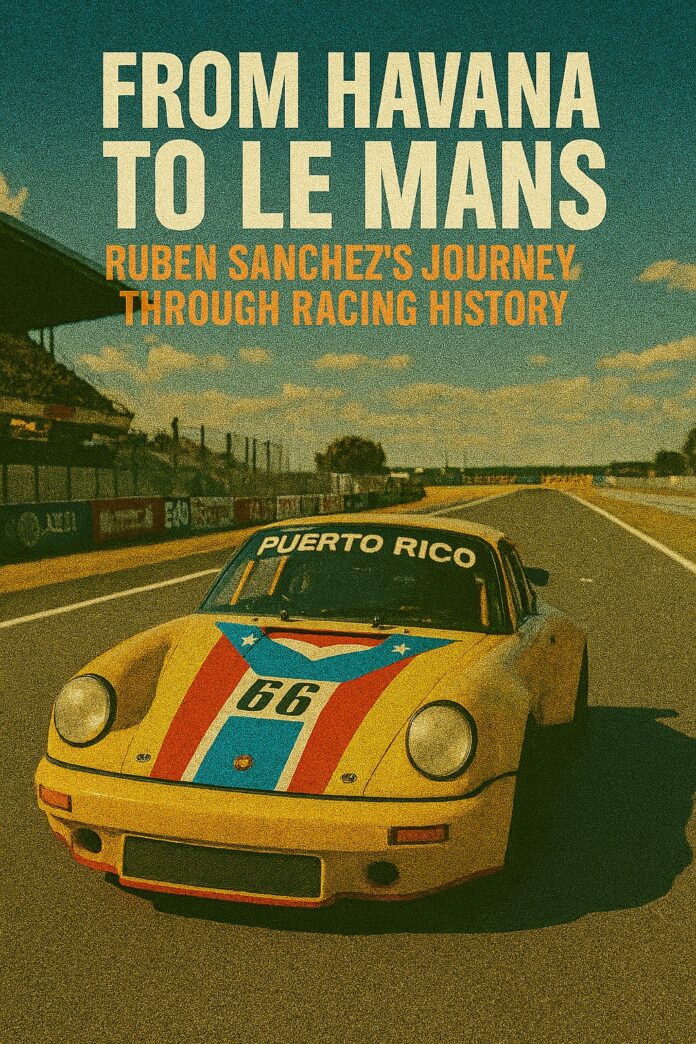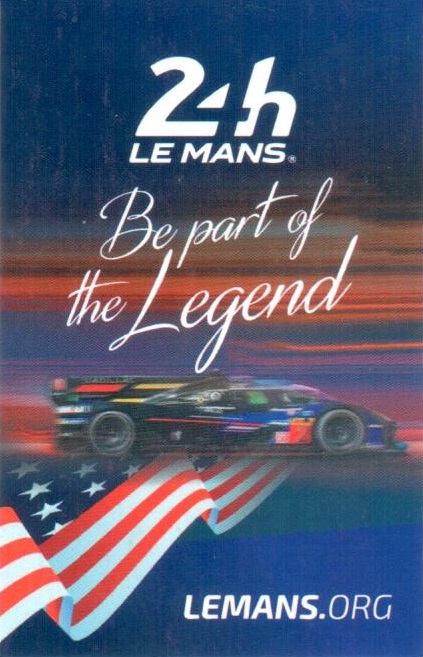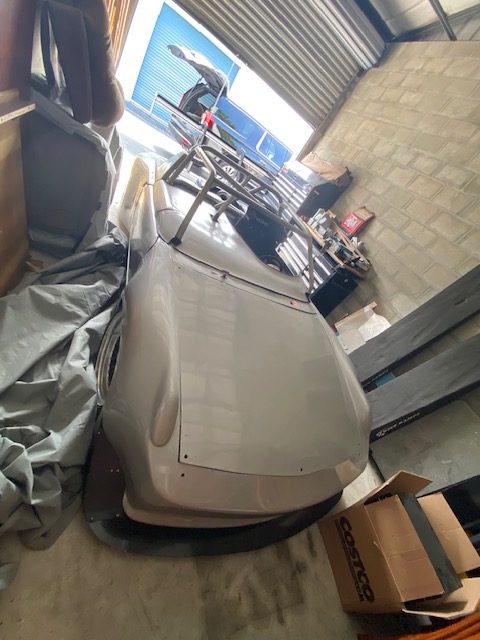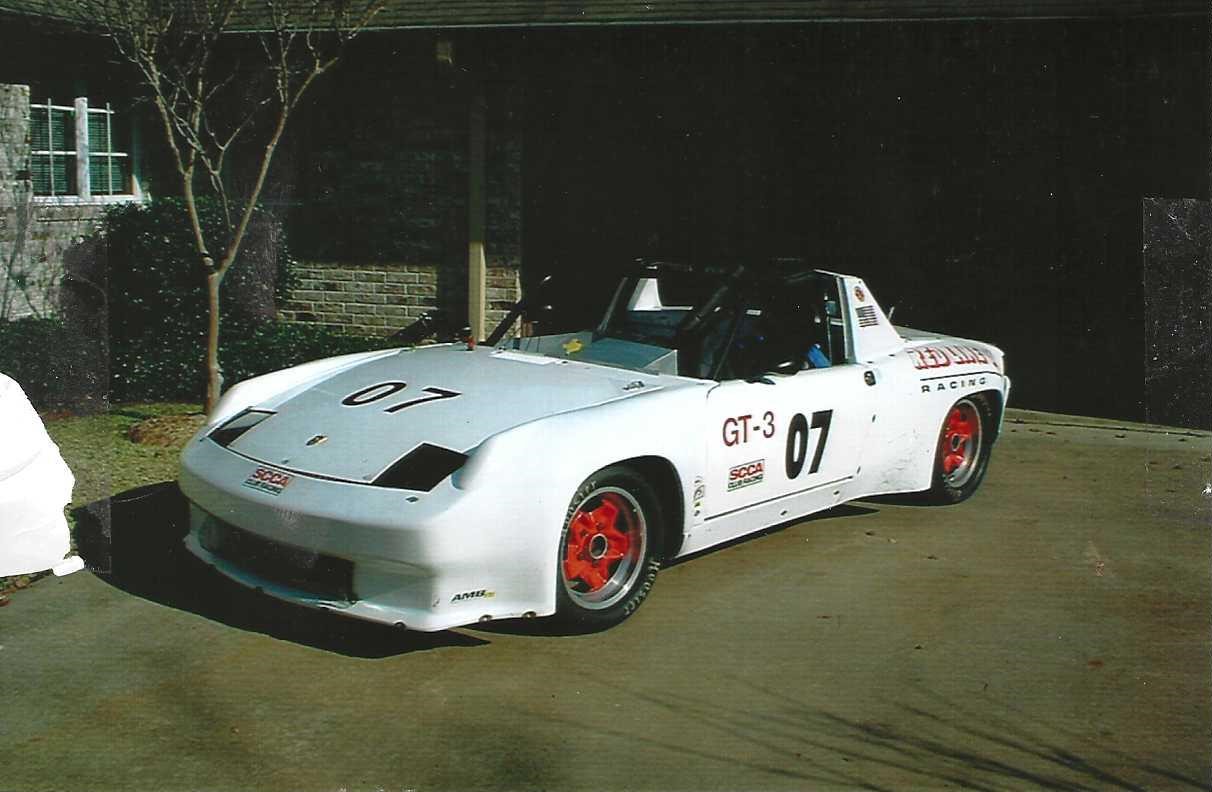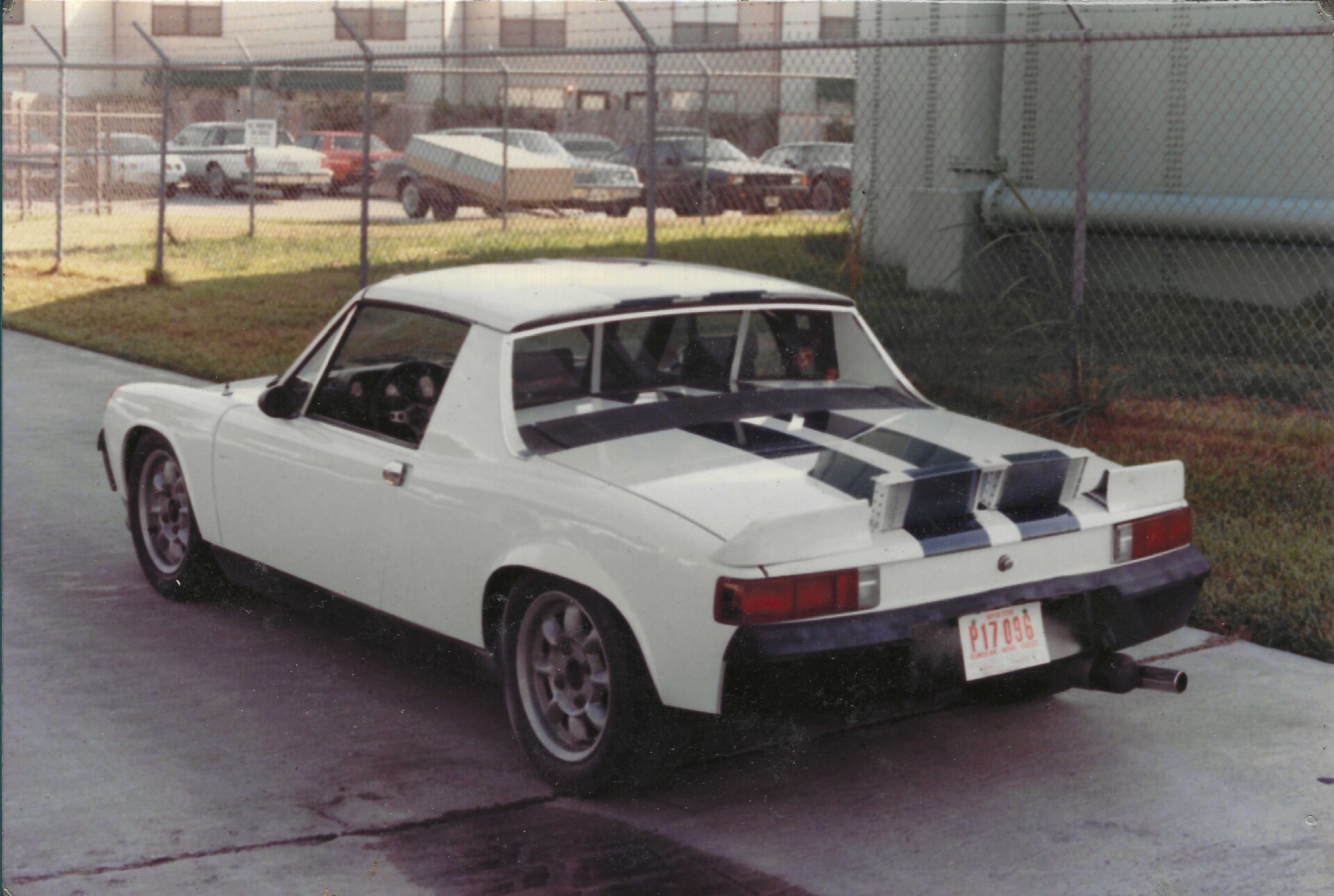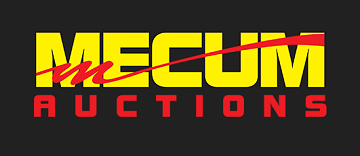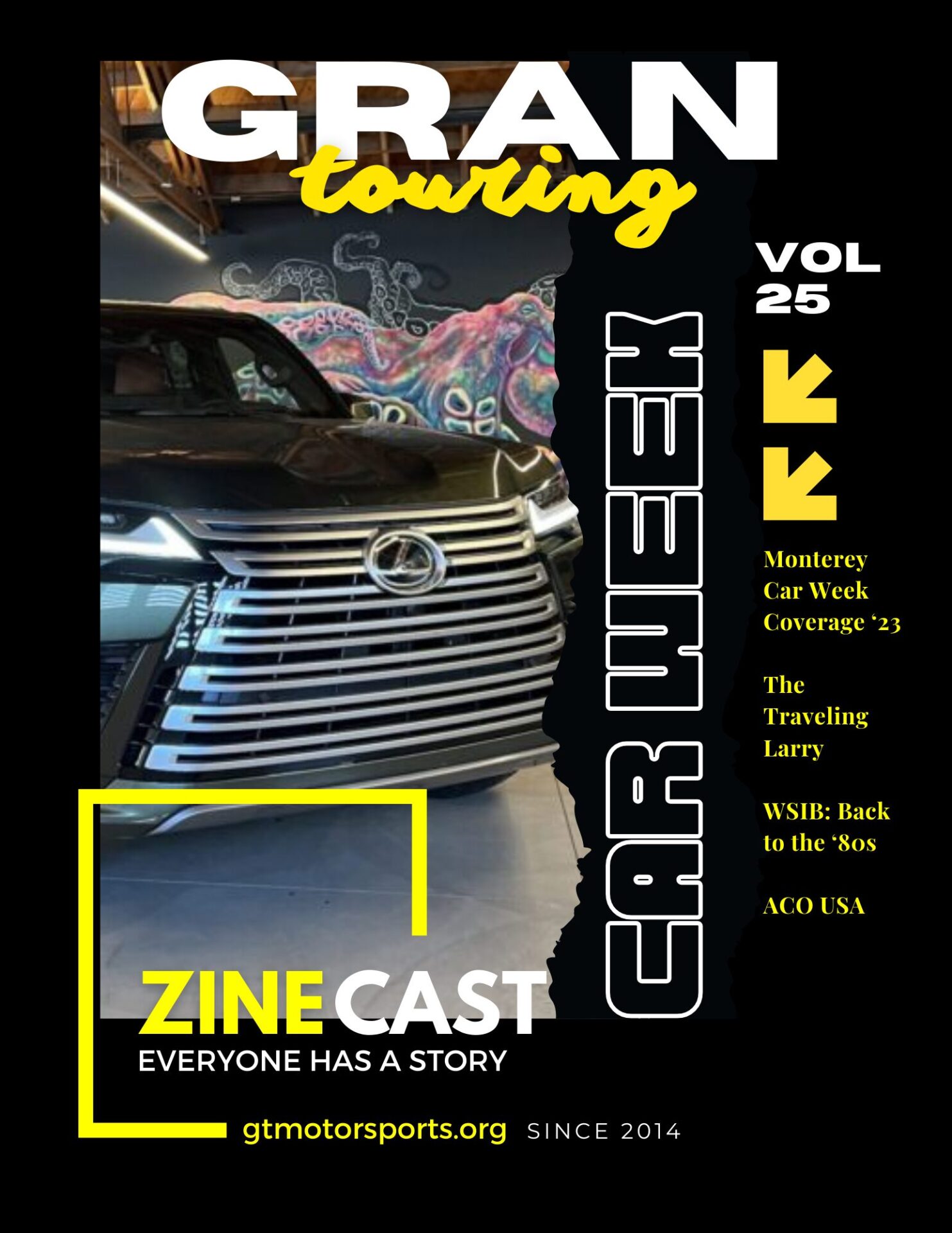In the golden haze of motorsports nostalgia, few stories shine as brightly as Ruben Sanchez’s. Born in Cuba and raised in the shadow of revolution, Ruben’s life has been a high-octane blend of family, resilience, and racing glory. His journey – from a toddler tugging on a Buick’s column shifter to standing in the pit box at Le Mans – is a testament to the enduring power of passion and the bonds forged through motorsport.
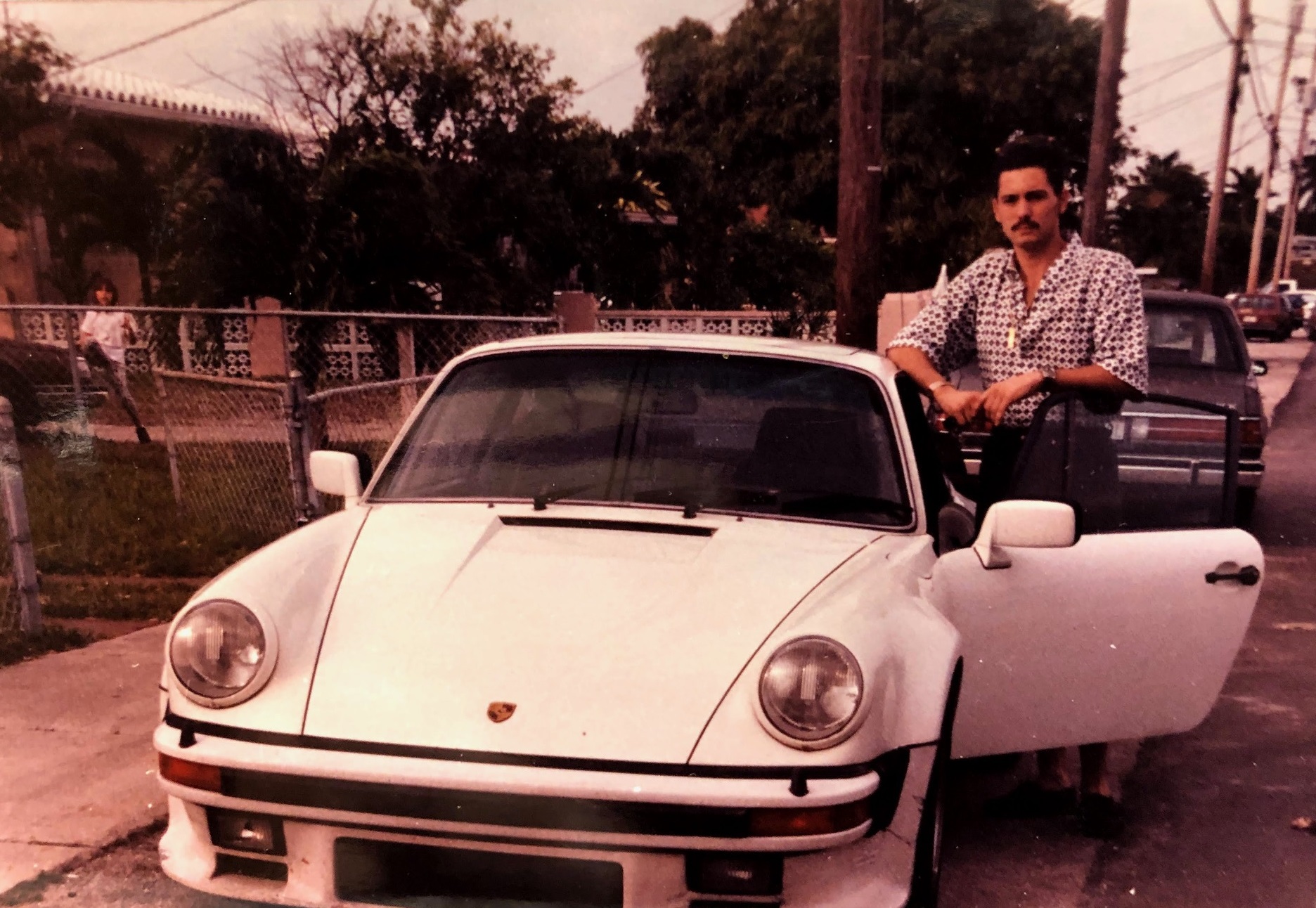
Ruben’s earliest memories are steeped in motion. At just 14 months old, he accidentally rolled his grandfather’s Buick down a hill – an omen, perhaps, of the speed-driven life to come. But Cuba in the 1960s was no playground. Under Castro’s regime, Ruben’s family lost everything when they fled the country. Sponsored by relatives, they spent two years in Spain before finally settling in the United States in 1969. “We left with nothing,” Ruben recalls. “They stripped you down to your clothes. Gold chains, property, everything—gone.”
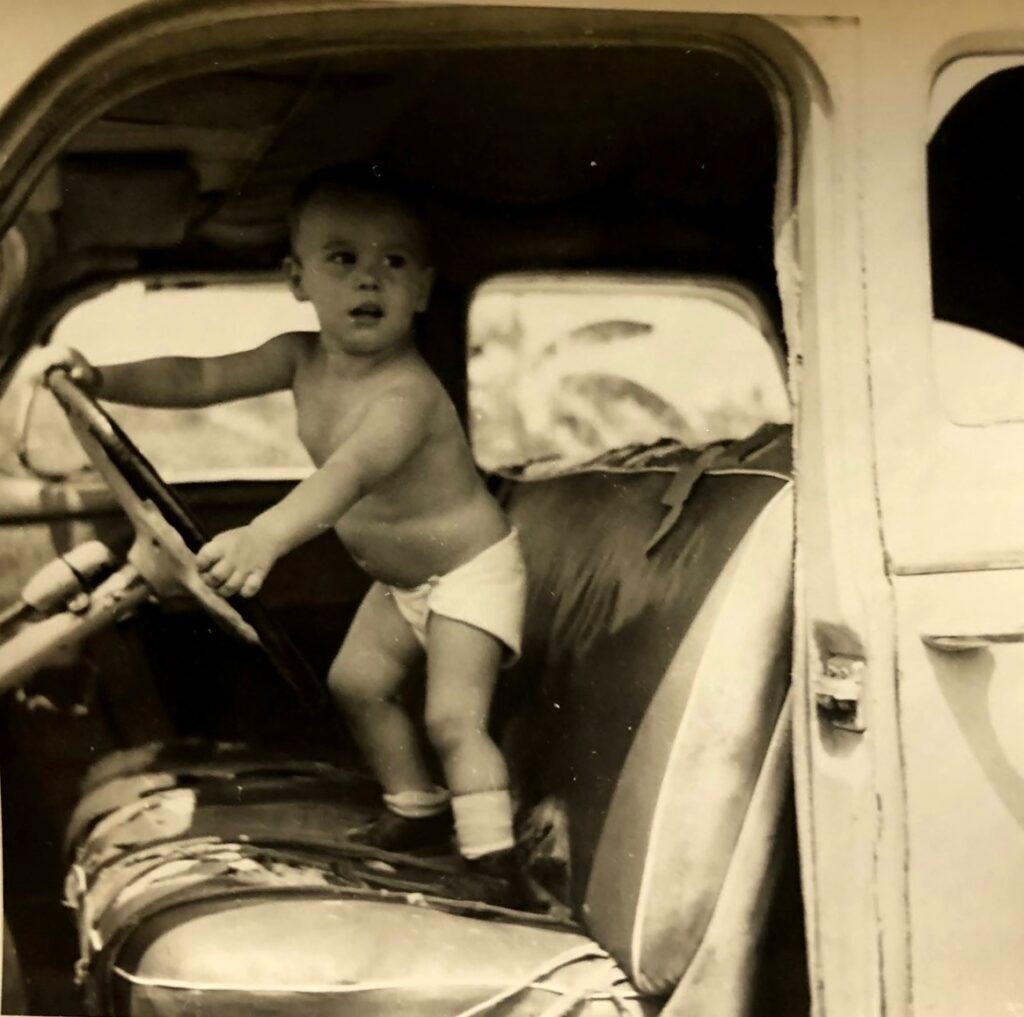
In 1976, Ruben’s grandfather passed away, and his cousin Diego Febles – an avid racer who had fled Cuba decades earlier – invited Ruben to join the family’s privateer Porsche team at Le Mans. At just 11 years old, Ruben found himself in the pit box, helping with tires and soaking in the gritty, grassroots atmosphere of endurance racing.
Tune in everywhere you stream, download or listen!
 |  |  |
The car? A Porsche 934 RSR, formerly a Brumos machine purchased from Peter Gregg. Painted in red, white, and blue, it bore the word “Puerto Rico” on the nose and a cheeky “Made in Jacksonville, Enjoyed by Puerto Ricans” on the tail. “It was amateur hour,” Ruben laughs. “But we were passionate. We worked hard, scraped together money, and made it happen.”
- Spotlight
- Notes
- Transcript
- Highlights
- Bonus Content
- Learn More
Spotlight
Ruben Sanchez - Chief Marketing Officer for Automobile Club de l'ouest (ACO USA)
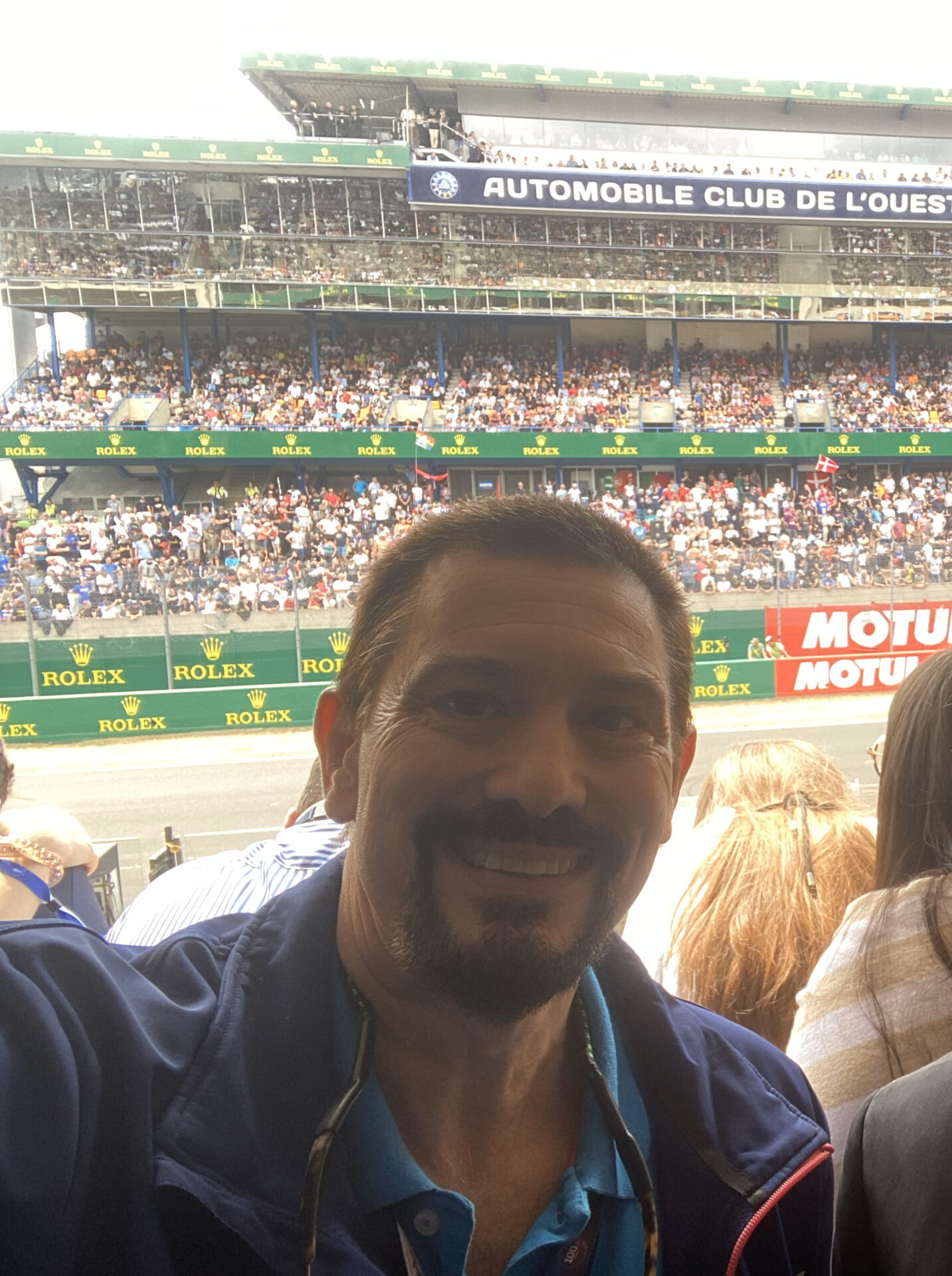
Head of marketing and social media for the ACO USA. Become part of the Legend.
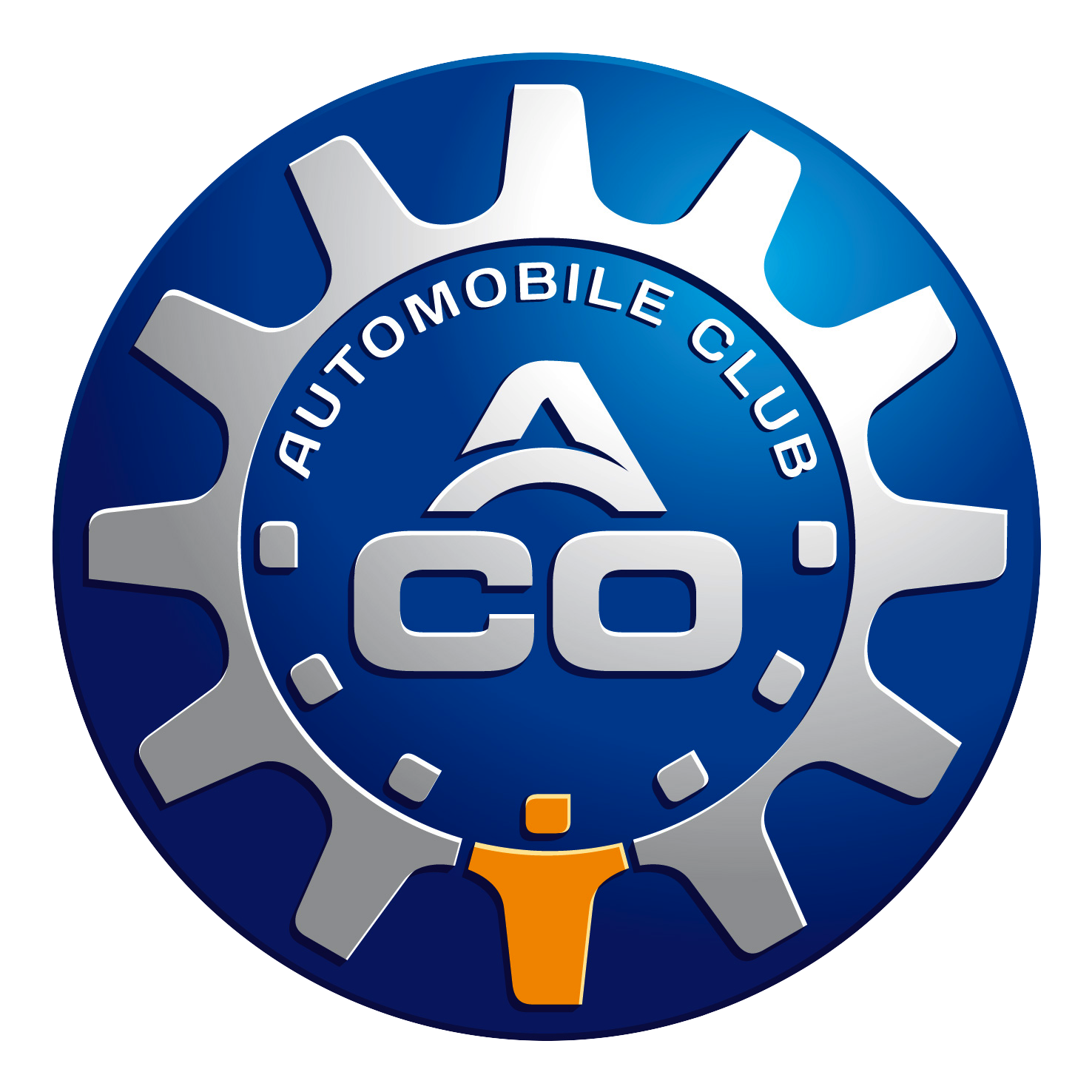
Contact: Ruben Sanchez at r.sanchez@aco-Le Mans.org | N/A | Visit Online!![]()
![]()
![]()
![]()
Notes
This episode of Break/Fix captures the life journey of Ruben Sanchez, the Head of Marketing and Social Media for ACO USA, through the world of motorsports, from his early childhood in Cuba to his extensive experiences at the 24 Hours of Le Mans. The episode traverses Ruben’s early love for cars, his family’s escape from Cuba, and his first experiences at Le Mans supporting his family’s Porsche racing team. Sanchez shares heartwarming tales of courage and camaraderie, explains the challenges of moving between countries under Castro’s regime, and details the intricate world of professional racing. He narrates stories from his time at Momo working alongside legendary figures like Derek Bell, and experiences driving iconic cars like the Porsche 917 and 962. Additionally, the episode highlights the benefits and initiatives of the ACO USA, emphasizing building a community of racing enthusiasts. It underscores Ruben’s commitment to nurturing amateur racing, increasing visibility, and celebrating motorsport legends.
- Start with the story about being 2 years old and stealing his grandfather’s car! (Ruben keeps a photo in his wallet) – picture it – Cuba mid 1960s
- Going to LeMans (1976, you’re 11 years old); how did that all come to be? Is there a story behind the 935? How did going to LeMans change your life? Do you think you would have pursued motorsports, had it not been for LeMans?
- Tell us about how you ended up working for MOMO – and Derek Bell and John Paul Jr. – Was this with the “MOMO 935” or the Ferrari 333 SP? (or both).
- You’ve remained a “Porsche Guy” for life. Early cars: 911 SC, 930 – is that because of LeMans?
- Your current track weapon is a 914/6 – tell us about that, the build, why a 914 over a 911?
- How many LeMans have you been to since? Who have you rubbed elbows with during all your visits to LeMans?
- What are some of your best memories of LeMans over the last 40 years? Thoughts – brief recap of the 100th?
Transcript
Crew Chief Brad: [00:00:00] Break Fix Podcast is all about capturing the living history of people from all over the autos sphere, from wrench, turners, and racers to artists, authors, designers, and everything in between. Our goal is to inspire a new generation of Petrolhead that wonder how did they get that job or become that person.
The road to success is paved by all of us because everyone has a story. This episode of Break
Crew Chief Eric: Fix has been brought to you in part by the A C O U S A, where you can become part of the Legend membership in the Automobile Club of the West. The founding and organizing body of the 24 hours of LeMans is open to all the club hosts events in LeMans and around the world, attracting fans who enjoy their shared passion for motoring and motor racing.
Get ready for a heartwarming tale of courage, camaraderie, and the pursuit of racing glory as we transport you back to the late 1970s in France where a [00:01:00] talented team of privateers from Cuba and Puerto Rico came together as a Porsche 9 35 racing team, united by their passion for speed and an unbreakable bond forged on the racetrack.
Joining us tonight is Ruben Sanchez, head of Marketing and Social media for the A C O U S A to tell us all about what it was like being in the pit box at a very young age at LeMans, supporting his family’s Porsche racing team, and how that changed his life forever. With that, let’s welcome Ruben to break fix.
Ruben Sanchez: Hey, thank you very much for that, Eric,
Crew Chief Eric: and joining me as my co-host is our resident sports car and endurance guru from the golden age of sports car racing. Mike Carr.
Mike Carr: You make me sound old, but thank you very much.
Crew Chief Eric: Let’s transport our audience back in our best Estelle Getty way. So picture it. Cuba, the mid 1960s.
Ruben, you’re two years old. That’s what set all of this in motion.
Ruben Sanchez: Absolutely. Like my parents tell me I was a Hellen since birth. I continue to be a Hellen. I was meant to drive. [00:02:00] That’s why I love racing my whole life. And I started technically, you could say, at 14 months old, my grandfather was working on his car was, which was an old Buick with column Schiff.
And he left me in the car and. Went inside the house somehow and I ended up yanking on the shift. ’cause I was sitting on the, uh, seat and the car started going down the hill comes out, the car is halfway down the hill and they’re like, where is he? He must be inside the car because that’s where I, I was, I had shared a photo with you that I still keep because I just can’t remember that day.
But, you know, I didn’t wanna get out of the car. I was just holding onto the wheel. But I enjoyed it somehow. And from there on, you know, it’s always been cars. Planes, boats go-karts. Big evil Knievel fan as a kid. So you know, I made my own evil Knievel attire with my grandmother, you know, until I jumped my dad’s car on a ramp and that was it.
My 100 cc motorcycle away. Thank God I’ve never been really hurt. You know, I’ve been lucky in that aspect. Thank the Lord. You’re from Cuba? Yes.
Mike Carr: How easy or difficult was it to move from [00:03:00] country to country, from Cuba? I am under the impression that that was a relatively repressed regime. Mm-hmm. You know, at the time that we’re talking about
Ruben Sanchez: Castro came in in 1959.
I didn’t leave till 66 and a half. 67. We had relatives here that were. Had already left like Diego Fales. He left in early 60 fifties, right around that time period. He raced there with, uh, Juan Manuel when Manuel the re revolutionaries came and got him at the Cuban Grand Prix. So around that time they left some of my other family members Le had left and had started businesses here.
You know, we didn’t have the, the same economic situation as they did, so they sponsored us and we had to go to Spain for two years before we could come here. You had to go through a third world country. So, you know, we went to Madrid and lived there till 69. And so I got here at around three and a half years old because you couldn’t come direct.
There was no communication, so you had to be sponsored to another country. So that’s how we pretty much all the Cubans that left in that era got here. [00:04:00] You know, the Ralph Sanchez and Diegos, all these Moscanoza, all the people that, that you might know of.
Mike Carr: I had been under the impression that maybe you were coming and going from Cuba, but what you’re saying is that you got out.
Ruben Sanchez: We never went back. Right. Okay. When you left, they took everything. Everything you had, you couldn’t leave with nothing. No. Any gold chain, nothing. They stripped you down to your clothes and that was it. So whatever you own, like the Bacardi’s lost their factory. They had to leave and go to Puerto Rico. All the Cuban cigar people that are in Miami, they left everything that they had.
It was, everything was nationalized, and you get outta here. Ones that had money, they kicked out, so they took their factory. The other people, they just keep repressing. Until today, people think things have changed here, but nothing’s changed here. It’s still the same way. We still have distant relatives there.
We have other people here that go there and 90 miles from Key West off our shores. You have such misery and socialism. Dictators. It’s a shame. So
Crew Chief Eric: once you finally got out of diapers, there’s a bunch of years between your first lama and that incident there with your [00:05:00] grandfather’s Buick. So tell us how you ended up going to France and being on this team in the late seventies.
Ruben Sanchez: Well, I have on both sides of my family, the racing family on my mother’s side, grandfather, my second cousin was Diego Fales. So, He was an avid racer. He left Cuba in the late fifties, right around Castro, went to Ecuador, then later Venezuela, and then eventually settled in in Puerto Rico in the sixties.
The way I got to Lamont was in 1976. My grandfather died in March, and Diego came back to the US for his funeral and so forth. And you know, when I was very distraught, I could put a Chevy three 50 together by the time I was 10 years old with my grandfather. My dad can’t turn to screw work to save his life still.
So I picked up everything either to God-given talent or because of my grandfather, you know, and I wrench and built all my cars. So I was distraught. And then my dad and Diego got together at the funeral and said, we’re gonna Lamont, so bring him with you. Come and be the team. So that’s how I got there.
You know, I was already a, a [00:06:00] lamonts fanatic from watching McQueen’s movie in 71. At six years old, to me it’s, it was already the holy grail and to actually be there, you couldn’t have really appreciated that time. But you get older, you reflect back, you’re like, wow, what an experience that was. You know, the garages are lousy.
There was just little, tiny, little silos, you know, open, noisy people in shorts, smoking and filling up the car, you know? I remember helping them with tires and moving stuff around as I’ve gone back over the years to see the contrast. Wow. How racing is now compared to those days. It was very grassroots.
Good old boys having fun today. It’s a whole different ball game with the professionals. Nothing’s left to chance.
Mike Carr: How did the team wind up there with the 9 35?
Ruben Sanchez: Well, it was a 9 34 R s R act. Okay. It was, I. Brumos car. He bought it from Brumos, from Peter, Greg. And it still had the same paint scheme except you changed the number, uh, to 78.
Mike Carr: Red, white, and blue with the stripes.
Ruben Sanchez: Yeah. It was a Bruno card, you know? Yeah. And then he put Puerto [00:07:00] Rico in the front. I remember that. And something I’ll never forget that he had in the back. I don’t know if he had it in the months, but later on, you know, that they used to make, made in Jacksonville for Brumos.
Okay. He had a great sense of humor, Diego, he wrote, but enjoyed by Puerto Ricans. You know, and so, so I, I always used to love van go pretty crazy guy. I mean an incredible Volkswagen, probably the fastest Volkswagen bug in for a quarter mile in Puerto Rico. So that just fueled my OSHA Volkswagen life my whole life.
Mike Carr: But this takes a lot of juice to put a car in a plane or a. Boat or whatever and get it over to France. And how did that work? What were their background? I mean, is there enough racing in Puerto Rico that that could be their full-time thing, or was this the gentleman’s hobby, I suppose?
Ruben Sanchez: Yeah, it was a gentleman’s hobby, but there was a lot of money in Puerto Rico that helped him to do it.
Lamont. We went twice in 1976 and 80, but he did race like in Sebring from 74 to 80 something straight for like 10 years straight in Daytona. [00:08:00] In fact, at one point, I think 77, it was second overall in Sebring, the 12 hour, but it was just amateur. Amateur guys. Really it. This was not no factory works team by any sense of imagination.
Just passionate about it and they really worked a lot of hours to do, you know, scrounge up money and whatever we could to get there, buying old equipment, basically. Pretty incredible story. What did you do next? I would go to Lamont pretty much every year with the family. With them or with other, from my dad’s, uh, father’s side at the Ralph Sanchez family side.
I would go there, I mean, I was there, um, in 79 when the Wintons won. That was a great time to be there as well. Then in 80, we went back again. Diego went back. We crashed in the 15th hour, unfortunately. So the two times there, there wasn’t bad the first time there. I think we had an engine failure. You do what you can, you know, not a lot of spare, not a lot of qualifying engines.
Only like today, you know, we scrounged up and did everything we could, you know, and then after that we kind of stayed more stateside because, you [00:09:00] know, the go to France is definitely a more expensive but. It was always a dream to do it. It’s been my dream my whole life. It’s yet racing is so expensive now that, uh, you know, unless you find, uh, somebody to, to finance that dream, it’s, uh, it’s very difficult.
Crew Chief Eric: Well, not only that, it’s near impossible to just show up to Lamonts anymore and say, I’m gonna compete. Correct. You have to go through all these other gates and all these other series and points and be nominated to be in one of the garages. I mean, it’s way more complicated than it’s ever been
Mike Carr: when you hear the stories of when that was possible.
It just blows your mind.
Ruben Sanchez: Yeah, you just showed up. You know, you could take your car if you had to get there. You know, you, you made it there. I remember that was the NASCARs were there that year. That was 76 was when the NASCARs were there. Big four 20 sevens were not that far away from our pit. And you know, I could hear that, you know, every time it went down, they didn’t last very long.
But those vivid things. So when I went back now for the centenary, you know, the 56 garage brought that back to memory very vividly. Again, you know, those are the things [00:10:00] that are seared in your brain and when we look at it back, it’s like, wow, back then everything’s possible. I had so many friends that raced in G T U and in G T O and A SS A as well, you know, which, you know, after the mid eighties, it just, It got to a level that it was impossible for, you know, the homegrown guys to show up.
Crew Chief Eric: So funny. It’s almost on par with like going to an S C C A event. It’s like, as long as you show up with a sack of cash to pay your registration fee you’re in, you can run at lama, you know, see how Lama chooses you at the end of it, right?
Ruben Sanchez: Correct.
Crew Chief Eric: Being there 11 years old and then again, you know, 15, 16 years old, the second lamanzi went to in 80.
You had to rub elbows with a whole bunch of people that now are considered lamont’s legends. And we’ll talk more about Lamont’s legends as we go along, but any folks that you met that now you realize that are of that stature much later? You know, there
Ruben Sanchez: was Redmond and there was Bell and Icks and so forth, and I knew them from Lamont’s.
The Lemons movie because they were in the movie. So I knew they were either actors or great race car drivers because there was for the movies. So those are the kind of ones I [00:11:00] remember at that period of time because I was, you know, very young. But from lemons, I remember that the ones that were in the movie, you know, later on going back.
For many years and different jobs and different opportunities, I’ve run into them again over and over again, and many, many more. And like I said, you don’t know at that moment because you’re so young, but when you get to reflect much older in your life, you’re like, wow, I, I’ve really had some great times.
I had really great memories to reflect back on.
Crew Chief Eric: And you mentioned to me when we were touring the Lamont’s Museum together, that you had a encounter with Jackie Hicks, the original Mr. Lama himself many, many years later after your original encounter with him in the seventies. And what was that like? It wasn’t in Lamont.
I went to Paul
Ruben Sanchez: Ricard for the Formula One race after the race. I was at the airport and Jackie was right in front of me with his wife. So always says, Jackie, you know, can I get a picture? Then we started talking. I said, you know, Jackie, you know, I, I was in Lamont. I first dive when I was in 1976 and then 77 when you won with the 9 36, I think it was the open tic car.
So we [00:12:00] just started talking. So we actually flew back from, I was going from Paul Ricard, Marcel, I think it was to Belgium. ’cause I was going to Belgium and, and he was going back home. So my wife and her got together in front of us. Him and me and Jackie did the, uh, you know, two hour and a half flight together, just talking back and forth.
He’s such a approachable and gentleman, you know, and very just grateful and a humble guy. Actually, I’ve met others that are totally opposite of that, but he’s, uh, very warm and open.
Crew Chief Eric: And in this whole time you’ve been still going to lama many times over how many Lamonts. Races have you been to since your very first one?
23, 24? I’d have to count ’em. When you look back over the last 40 years of LAMA or more now, almost 50 years, some of your best memories? The
Ruben Sanchez: memories that have the greatest impact? Definitely in 76 and 80, because, especially 80. ’cause I was 16 years old. I could definitely remember everything then I remember seeing Paul Newman and some of these guys that I could appreciate at that [00:13:00] time.
So 1980, probably, you know, number one. In my mind, I was there, I was in the pits, I was behind the scenes. I was helping, checking tire pressures on car, doing whatever they, you know, we had to do. You know, we didn’t have 30 people. We, we had maybe eight people total, so we had to do whatever it took. You know, as far as being a participant in a way, that’s probably the best memory.
Mike Carr: You talk about 1980, that was Alan Cone racing there that year. We just lost him.
Ruben Sanchez: Correct. I used to watch his series all the time on Speed Vision.
Mike Carr: Yeah.
Ruben Sanchez: With the Ferraris and stuff. Yeah. He was very eloquent in and
Mike Carr: what a gentleman.
Ruben Sanchez: Yes, absolutely. There’s so many memories following the Rothmans and the Porsches and I think 83 when you know, a car was broken, I think with the door and in 85 again, Derek and Hurley and Al.
Yeah,
Mike Carr: that that was the Bell Holbert
Ruben Sanchez: era. Yeah. Yeah. Then with the Silk Cats, With the saber, I remember going, went with the Mercedes flipping Po. Joe’s wind. Mazda’s wind, you know, and, uh, magni just eating the wall right there on the Dunlop curb and I’m on the opposite [00:14:00] side.
Mike Carr: That was terrifying.
Ruben Sanchez: And that was right across Chappelle,
Mike Carr: like where it went into where people were, yeah, yeah.
And
Ruben Sanchez: yeah, that car got destroyed. You can see the, the wheel, the hubs, and the whole axles flying off the tub. Incredible. The carbon fiber tub is incredible. You know, in, in the Jackie Stewart era, back in that tin can with, with two race fuel tags, it was a whole different thing. Nobody would’ve survive anything, period.
So I, I mean, I would go like every other year or every two years or so, I would start there and then continue on a vacation. I’d plan everything around lamonts. It’s been my holy grail.
Mike Carr: I’d like to understand whether or not these were crew gigs or you’re on vacation, or it’s just important that you be there.
Ruben Sanchez: Important that I’d be there. The only time that I’ve done some crewing was for synergy racing in Grand America that I did it a couple times with David Murray and one of the doctors from Team Seattle. It was in Synergy and so forth, but no, the other time, just because I love being around the smell of a hundred into a octane and burning rubber and, and just the noise.
Mike Carr: We all share [00:15:00] that. Yeah, it run through the. So good.
Crew Chief Eric: So do you think if you hadn’t gone to Lama you would’ve still pursued motorsport?
Ruben Sanchez: Yeah. I love things that move fast. So whether cars, planes, boats, it don’t matter. I, I’ve done it my whole life. I, you know, I, I’ve always somehow tried to get in. One time in the eighties, I worked for a dealership that was here in Miami and uh, the owner raced offshore boats.
So I got myself in there. I, I would working at the dealership and doing mechanics and so forth, but then I would go at night to go work and then it was a Ford dealership, so we were the only ones that had Ford Engines. Everybody runs Chevy 4 54 more cruisers. So we had Jack Roush engines and I got to go and do a several races.
In fact, in 1887, we won the Peace Sportman class in, uh, key West at Worldwide Championship, you know, doing 112 miles an hour. On the water. I, I’ve had great opportunities, you know, and, and been kind of lucky in some spots to get in some of these. So I’ll get into anything you give me, just if it moves, I love it.
You know, it could be rally, could be, [00:16:00] you know, drag car, jet car, Lamont, uh, you know, like moving fast.
Crew Chief Eric: You’ve had a really interesting career as well, obviously focused around mechanics and cars and things like that. But there’s a period in your story, and I think it’s fascinating, and I think Mike and I both wanna dive into this a little bit deeper.
You worked for Momo. So how did that come to be
Mike Carr: Jean Piero Moretti of Milan? When you talk about Momo, it’s Moretti and Manza. Yeah. Mo Mo. Correct.
Ruben Sanchez: Yeah. And it was a great guy. So generous. He was great.
Mike Carr: I have a friend who Eric knows who says that he loved the ladies and he was sponsored by Penthouse.
Ruben Sanchez: Yeah.
Mike Carr: And he was from a rich Italian family and there had to have been a million stories there. Did you see any of that stuff?
Ruben Sanchez: By the time I saw him, he was married and his wife was at the races. So, you know, he came from very affluent Italian family and he didn’t go into the business. He loved racing and, and that’s how he developed the wheel.
And [00:17:00] then Enzo said, okay, you’re gonna do all my race car wheels and also my streetcar wheels. And that’s how Momo got launched.
Mike Carr: He convinced Enzo to let him do it his way. Right. Enzo liked wooden wheels and Right. Momo said, we’ve gotta cover them with leather. It’s going to be. A much better wheel.
Ruben Sanchez: You know, you need that grip for a Formula One car or whatever in the case.
So, and then the rest of the story from there, it took off and then he really, uh, expanded into other things, including, you know, in the nineties when I was with him doing the eyewear and all that. So it’s definitely a playboy lifestyle. He didn’t flu it very much, but yeah, you know, I, I saw a lot of stuff here and there, you know, not looking for gossip.
Yeah. No, no. And I enjoyed that lifestyle too. Why not? I actually worked before Momo. I ran a chain of tire stores and when the Momo idea wheel came out, which is this Icep spoke wheel that used, had a little bracelets you put on it and changed the color, I sold more than anybody in my store. You know, because I love [00:18:00] Momo to begin with.
I, you know, even before the Idea Wheel. So I got invited to the office for a V I P event. I met Reti. We started talking and since I spoke Spanish, you know, he says, you know, would you be interested in handling Latin America and the Caribbean? And I said, yeah. So I actually became director for Latin American.
Caribbean since he knew I nobody in the office really in Miami, was a Motorsport guy. I was the only guy who was always of all racing. So I definitely build a bond with him. Every time he came. He would say, I’m gonna walk into, then fly up and, you know, He would send me the tickets or a plane. So I, I did that.
We enjoyed the 9 62 with GE Hart for a couple years and then 83 Nissan g t p that he ran with Kevin Doran as the, you know, the team. So some memorable moments, like 93, I think CBR was reigned that stopped the race for a while. And we came in second after Dan Gurney Eagle. And I remember John Paul pissing in his pants because he couldn’t hold it anymore, you know, sitting in the car in the rain, but it doesn’t matter.
[00:19:00] Flush away with the rain. I. A lot of those stories that I go back and go, wow, it was good to be behind the scenes there. That’s kind of why I started the evening with the Legend because there’s these stories that I heard, and I wanna try to get the legends while we still have ’em alive to get their story out as well.
Crew Chief Eric: When we step a little deeper into the Momo story, and there’s some pictures that go with this that are in the show notes along with the episode, you sort of circle back to where you were as a kid. You talked about Derek Bell and Jackie Icks, and you find yourself, as you mentioned, working with John Paul Jr.
But. Also at Derrick Bell at Momo. What was that like to now be there shoulder to shoulder
Ruben Sanchez: with one of your heroes? Well, that was incredible. I spoke to him and I, and about my time there, so we kind of bonded on that. And I met him on plenty of times throughout the years. And he lives down here in Vero and he couldn’t believe he, you know.
Yeah, I know plenty of people there, so he doesn’t remember me. I said, but I remember you because Lamont, you know, you were like one of the heroes in the movie and I definitely remember you. You, you weren’t a main character, but I know you were there just like Redmond and so forth. So [00:20:00] as I moved older, you know, in the nineties, talked about that.
And then, you know, his experiences with the nine 17, much later on got to drive a nine 17 because I have a friend up in that Long Island that had a Martini nine 17. So I drove it 2015 or so at Palm Beach International because Brian Redmond has a Target 66 event. So I got to drive Greg Skar. He’s a collector.
He has a quite a bit of cars, a a three 12 PB Ferrari Can-am car that I’ve driven in Road America as well. You know, I, uh, I got to feel that movie by being the real car. Finally, you know, miracle, you know, because I had a girlfriend that lived in Palm Beach and this gentleman lived in Palm Beach and the girlfriend later became my wife.
I don’t know if the karma brings you in circle. Back to that. How else would I get into a nine 17? Do a couple laps with it, so let’s hear about that. What’s it like? So let’s go there. Yeah. You know, I didn’t push it very much. Even then you could see it, it wanders a lot, those Avon tires or driving a [00:21:00] modern car with slicks, you know, it, it, it’s, it’s a different ballgame, low profile.
It definitely needs brakes compared to modern cars, but that’s how when you just gun it a little and you hear that from that vertical fan, it just raises the hair of your back and it makes your butt. Kind of fucker really. You feel it
Mike Carr: move. How would it have been to have been in that car over a 24 hour race?
Ruben Sanchez: Just to imagine doing Ong with no hairpins at 252 has, Derek would tell me that they were doing back in the day. It was a story from Bert Zinger that told me once that, you know, he told him that you, you did this, you know, He goes, that’s translates 252 miles an hour. And he said, well, what about if I did 100 RPMs more past redline?
Well, that it, you would blow up. You know, I heard that from Dover with talking Derek many years ago. And I, I was like, wow, what a, what a concept, you know? Yeah. I would imagine that’s what the redline there for.
Mike Carr: Limiters are only good on the way up. When you money shift, they don’t work.
Crew Chief Eric: Yeah. So you drove one of [00:22:00] the G T P Ferraris as well.
You also mentioned the 9 62. How do they all compare? They’re all very different. The
Ruben Sanchez: Ferrari, the three 12 pb, just trying to work the gate. It looks like a little toy. It’s just a little shifter with the ball and you have to be so precise just to get it in there. Acceleration is yes, definitely accelerates incredibly.
That car had a, a next sneaky load, a Formula One engine in it. It’s a different V 12 compared to the nine 17, but it was an incredible event that, you know, the tires are very tiny in the front. It’s whole different serious under steer. Yeah, absolutely. Yeah. It’s, it’s terrifying. Well, it’s, it’s a gentleman’s race and.
Vintage of ad, you don’t really push it. Nowhere, anywhere, the limit. I respect these cars because I can’t afford ’em. And uh, yeah, I don’t definitely want put that kind of a vehicle on, on a wall. I think that car my friend had sold me, now it’s about 7 million bucks, you know, back then, I don’t think it was that much a couple years ago.
But, uh, these cars have gone price points at or strato fair [00:23:00] right now?
Crew Chief Eric: Well, the 9 62 was a ground effects car,
Ruben Sanchez: so that must have handled completely different again, I didn’t drive it very fast. Let me do a, a lap or two at Seing for testing once you know how Sebring is with the da da. So if I drove, it’s 50, 60% maybe that, so you don’t really get to push it in the corner, keep that ground effect.
I can’t say I could feel it because I, I respected it. I, it was if something happened to that car, you know you’re not
Mike Carr: gonna mess it up.
Ruben Sanchez: Right?
Mike Carr: Yeah, yeah. Priority one,
Ruben Sanchez: I could drive it in anger. I would love to, but I know I, you know, it’s not my machine. I have to, you know, keep the throttle up.
Crew Chief Eric: Well, they say though, if you’re not at a certain speed with a ground effects car from that period, any of them, they don’t stick.
They’re very unruly.
Ruben Sanchez: Yeah. I mean, a straight line and you know, in Sebring when you’re doing the straight, not a problem, but when you start going like turn one or whatever, It’s really high speed, but again, you know, you gotta say, okay, it’s not my car. Plus if something happened already would fire me. So, so I’m like, okay, you know, I appreciate you at least letting me do it, but I [00:24:00] know how to respect the courtesy of what he, he allowed me to do.
Crew Chief Eric: So at this time, Momo in the early nineties, they were campaigning the Ferrari 3 33 sp. Was there anything else going on or projects you guys were working on? Stuff that was kind of exciting
Ruben Sanchez: that started after I left. He was trying to get Ferrari to get into prototypes for years it never happened. And then finally he convinced Pietro to do a car.
And then so Pieto contacted with Delara. He worked on that car to get that prototype for the regulations. So that started, I think in 94 and he worked until about 98. I think he won Daytona around 98 or so. You know, I wasn’t working m all but I would go to the races and see them and, and be in there. Even though I was in no longer a mobile, I was actually working at Penske at the time, but with Penske, I never met Penske at, at the track or did anything with him.
But yeah, I mean, I love that car B 12, you know, it’s a whole different ballgame from, uh, the three 12, you know, the B 12, but, but now you’re [00:25:00] talking ground effect. It’s kind of a, the evolution because really that three 12 really became the 3, 3, 3. If you look at ’em, they’re so very similar. In every way, you know, open cockpit, just the evolution.
Definitely. You know, a decade later,
Crew Chief Eric: and as we know it wasn’t a Lama’s winner because Ferrari hasn’t won LAMA until this year, it’s been 50 years. It was the big body cars, which were the last ones to win at lama. So it’s kind of interesting, all this development still ongoing with Ferrari, you know, all their trials and failures along the way.
And we’ll get more into the hundredth here as we go along. Obviously the first LAMA you went to in the seventies left a lasting impression. You went there with a Porsche team, a family team, Porsche, and vw, as you said, has been in the blood for a long time. You find yourself on a personal level, still entrenched in the Porsche world, and you’ve remained a Porsche guy for your life.
And you shared with me some of your early cars nine 11 sc, 9 39 11 Turbo. Have you kind of ventured away from that or has it always
Ruben Sanchez: been just Porsche? Porsche, Porsche. I’ve had Corvettes too. I, you know, I’ve enjoyed [00:26:00] Corvettes as well, but my first car was a nine 14, which I still have today, and that’s my race car that you see.
I’ve had it since I was 16 years old.
Mike Carr: The nine, 14. It’s a six.
Ruben Sanchez: Yeah, it’s a six. It’s a three, two short stroke that I built.
Mike Carr: Let’s hear about this.
Ruben Sanchez: Yeah. It wasn’t a six when I bought it. It had a. Volkswagen engine. I, I souped that up as much as I could. Basically a two liter. But eventually throughout the years, I, you know, I, I got an SE engine, took it apart, and then started putting it together.
Gone through so many generations, over 40 years, probably, you know, I started doing autocross with it. Then eventually, you know, racing Ss C C A and Porsche Club and stuff like that. And by now it’s almost like a Lamont prototype, because I have a swan neck wing in the back. I got almost ground effects in the bottom.
I mean, I, it has no windshield. It has, you know, low drag. I got the whole cockpit enclosure that I built a, a cover for. So it’s just my helmet in the wind. I’ve gone really radical with it. So, you know, the sail panels, fiberglass, everything on the car is fiberglass except for the, you know, the basic structure, the front tube frame and the back is almost tube frame too.
[00:27:00] So, and it’s a sheeps and wolf clothing. And I love that. I love the underdog. You know, like we were on TikTok, you know, as a 14 coming up. You know, compared to factory teams at Lamont and throughout racing in life, period.
Crew Chief Eric: Are you in e prepared with that car or one of the other classes? G T
Ruben Sanchez: two. Okay. G T two.
Okay. Yeah. 1900 pounds at about 350 horses. 50 P M o Webers. I mean, it’s got everything in there. Billet heads from C M W, I mean the works, all the uh, VOS stuff at the gearbox, even interchangeable first gear 9 93, big red brakes, you know, you name it, that the car has everything.
Mike Carr: We’re gonna be able to put some pictures.
With this.
Crew Chief Eric: Oh yeah, I have ’em. Ruben’s already sent ’em. Yep.
Mike Carr: Yeah. Alright, perfect. It sounds amazing.
Crew Chief Eric: Coming up through nine elevens and owning several nine elevens. Why did you settle on a nine 14?
Ruben Sanchez: Because it was my first car, but I’ve had a whole bunch of nine 11 race cars as well. I had a cup car, 9 86 cup car that I drove for a while.
I had a, uh, a 9 34 type r s r that had built this well, that I enjoyed.
Crew Chief Eric: Yeah, but the nine fourteen’s still around. That says something.
Ruben Sanchez: Yeah. Yeah, because it was the first and you, [00:28:00] you, you know, it’s like you keep that. But you know, the nine 14, that mid-engine compared to the Porsche, you know, you know, and when I take it racing now with some newer cars, the nine 90 threes that are out there, 9 96 s and a, you know, and they get blown by, by the nine 14, they’re like, wow.
Well, you know, horsepower, the weight ratio mid engine. So you could come in, you know, earlier and you know, more hotter on the apex break later, slide it through with the mid-engine, you get better stability. So those things add up to lap pipe. Some of these guys. That have the big wallets, they get blown away from this car that’s 40 years old that I built.
I love it. For that reason, I don’t get rid of it.
Mike Carr: Everybody in a R and W R L are moving towards Caymans and you know, there’s some brilliant cars. It’s the same idea as the nine 14, but they’re just spending $200,000 to. Do what you’re doing with a lot of development over the years. Mm-hmm. I would love to see you show up and blow them away.
It would be so much fun.
Ruben Sanchez: Oh, I usually do in, they’re in, in a race with, you know, they’re with their, [00:29:00] uh, nine 18 spiders or GT four caveman that I come with this, you know, 19 74, 9 14, but you know, they’re a thousand pounds heavier in most cases. Yep. I’m in 1900 pounds, so, you know, weight and mass, it’s just, And engineering.
It’s, it’s quite simple
Crew Chief Eric: and I think it’s a lot of fun too. ’cause as you know, I’m a nine 14 guy and actually one of the LeMans legends who we hope to have on the show here in the near future, Margie Smith Haas is also a nine 14 gal. So we bonded over that when we were at. The hundredth, which was a lot of fun.
And it’s such an interesting community of folks and that’s why I always ask. It’s like, what’s your nine 14 story? You know? It’s always kind of fun. Yeah.
Mike Carr: I like nine fourteens when I was a kid and I’m at Al Bert’s house and he’s giving me a whole bunch of posters and one of them is a nine 14, and I’m like, that one is gonna take a place of prominence.
I don’t know why I liked it so much. ’cause I had never driven at that point, I’m probably 11 years old. He handed it to me and I. Put it right up on my wall
Crew Chief Eric: and talking about Lamont’s, I think it was 1970 where the 9 14 6 GTS came in behind the nine [00:30:00] 17 to take a podium. For those of us in the nine 14 community, we hang our hats on that.
It’s like David and Goliath. Correct. Right. And it’s like, that’s super awesome to see that underdog of a car, not Porsche’s flagship, right behind what would be considered an L M P card. Today it’s, it was pretty cool. Even Brumos,
Ruben Sanchez: they have the Orange nine 14. They still have, you know, with the Richie Ginther.
Without the windshield, when you remove the windshield, that car changes completely. You know, it’s such a, a low drag car. Yep. In the mid-engine. Absolutely. You know, Porsche had to go back to mid-engine with the, uh, another nine, nine, whatever the number we’re at by now. I, I lose track of the current once, but it’s a mid-engine car because, You know, it got to a point that you cannot do any more development.
Crew Chief Eric: And it’s kind of funny you mentioned those early teams campaigning nine fourteens, a lesser known trivia question, but the first Jagermeister Ade car was a 9 14 6. Right?
Ruben Sanchez: Right.
Crew Chief Eric: And they’ve had hundreds of cars since then. But it’s kind of funny that all roads start there and yeah. And you
Ruben Sanchez: had the, the Kenwood car as well, that black Kenwood car.
It was, it’s been a [00:31:00] couple of ’em here and there. Of course, you know, the other Porsche nine 11 have been more predominant, but there’s some big success with the nine 14. You know, a lot of people take them for granted.
Crew Chief Eric: What’s also great about this is you have made Motorsport part of your life, and not only on the professional stage being at Lamont, being part of Momo, being part of these teams, but being back at home in Florida, you have some great racetracks in your backyard.
Obviously you have the Daytona Rolex, you’ve got spr, you’ve got the firm, you’ve got other stuff. You’ve found yourself in S E C A and nasa, as you mentioned before, having made Motorsport part of a life. I wanna ask you a pointed question for our younger Petrolhead that are listening to this. Why should you get involved
Ruben Sanchez: in amateur racing?
I’m gonna take this from Ben Keating and I think he’s had interviews about this. It’s the only place where an amateur could come in and play in the Super Bowl because Ben is an amateur. He’s a car dealer. He just won Lamont. He’s won twice now, back to back Grassroot Motorsports. I’ve raced with a lot of people, poco that raced and Spec Miata with me.
There’s a lot of people that have made some improvements [00:32:00] and uh, and moved up into some professional cars now. So there’s opportunity and you have to start somewhere. You know, unless you know your name is Stroll or Andretti that you have money or a name, it’s very difficult. So you kind of have to pay your dues from the bottom up and, you know, at least either you start with carding
Mike Carr: when you’re 10 or eight.
Yeah, or four. If you, if you really
Ruben Sanchez: wanted to build your racecraft. But you know, you could start in the spec Miata. One of our members is a female from Texas and she’s trying to make it in the world, and she’s doing Spec Miata. She’s trying to get to the, the Global Miata Cup. Those are still somewhat affordable, that level.
Because beyond that, it really jumps up. But it’s an opportunity where maybe you get spotted if you have something and you’re at the right age or even the right look. And that’s why I think without the grassroots, there might never be the pros because you know, where do you come from?
Mike Carr: You’ve spent a lot of time at a bunch of different tracks.
What are your favorites? What do you hate? If you hate any
Ruben Sanchez: homestead? My home track. You like it? I hate it. There’s nothing there. I’ve been in a lot of [00:33:00] tracks all over the world. Spa Manza. I love Road America in the us. I love, I love Road Atlanta. I love tracks. They have natural terrain, blind corners coming off a
Mike Carr: hill.
You’ve run at mid Ohio, obviously.
Ruben Sanchez: Yes, yes. Another great track.
Mike Carr: Same idea, yeah. Yeah. I was at Road America for the first time last year and I was driving the PACE car Corvette C three. It was so much fun. To be able to take it around easy and then just nail it, bring in the pack around. Right. Didn’t have to worry about whatever that Canada corner or whatever it’s called, like where people crash because the walls are so close.
Crew Chief Eric: It’s like turn nine at the Glen. The runoff is about three inches.
Mike Carr: Turn 11. You want to put your mirror on the concrete. Yeah. It’s a lovely track, but you’re at risk all the time. Yeah. Road Atlanta turned 12 coming down off the hill between the bridge, the nine 10 complex. Right. And looking at that wall in front of you is just terrifying.
And. Fun,
Ruben Sanchez: but you do like homestead. It’s kind of boring, you know, Daytona’s Daytona and in the banking [00:34:00] and so forth. But again, it’s just a couple straits, a horseshoe, you know? You know, I like v I r, that barber. I, I really like lots of corners of blind corners, the off camera, because that’s where you really excel and, and grow.
You know, anybody can drive a car. Straight, but straight lines are fast cars, but fast corners are, you know, fast drivers. So I always wanna improve my skills. So the more challenging, the more corners, the more blind, the better. That kind of gets my juices going.
Mike Carr: So have you had any chance to get around Lamont?
No. Oh, that’s gotta kill you.
Ruben Sanchez: And my friend that I know doesn’t go over there, doesn’t take his cars there. That’s one of the reasons when a c o called, you know about starting a focus group or whatever. I jumped on board doing the communication because they go, well, if I can make that connection with someone, then I’ve been trying to make that connection my whole life.
You know, with mobile, we’re you name it. Try to get on that track one day on a, in a car with, on a classic, probably most likely.
Mike Carr: Have you been to the ring?
Ruben Sanchez: Yes. In fact, when I went before the pandemic, so maybe [00:35:00] 17 or so is, is when I went, I rented a g T three from a facility that’s there. I think it was 300 and something, a lap with the car, but it’s fine.
I did three laps. I figured I’d blow a grant. The first lap out, the, uh, ber ring queen was SAB beam.
Mike Carr: Yeah.
Ruben Sanchez: She was going out in a, in a beamer with some people. So I said, I’m gonna follow her.
Mike Carr: Oh, perfect.
Ruben Sanchez: So I learned as much as I could following her, I said, all right, I, I’m gonna stick with her, like bubblegum.
So that helped a lot coming blind. I mean, I’ve done it in the simulator and so, so you kind of start remembering stuff, but it’s never the same. Figuring out like on, on the hairpin and the cam and it really turns on. You don’t really feel it in a simulator. You know, you. You see it, but you don’t feel it with your butt.
Mike Carr: If you were able to keep up with Sabine Schmidt, I am impressed.
Ruben Sanchez: Well, I had a much better car, I think.
Mike Carr: Okay. Than the beaver. Oh, she’s doing the van. Yeah. Right. Yeah.
Ruben Sanchez: So I have, she’s three yards. She’s in a whole bunch of people in the car, you know, so I’m like, okay, but at least I know where she’s going.
That’s the optimum line. Then I went out, uh, I did [00:36:00] great. I didn’t crash on my third lap. Half of it got stopped because, uh, three 50 zx and another car crashed. That’s a problem when you go there, you know, you never know who’s driving there and they crash. That’s it. That ruins your opportunity to have a good lap and fun, but at least I got one great lap, one lap behind her and half a lap before it became upon the accidents.
Crew Chief Eric: We’re all still coming off of the hundredth anniversary high, if you will. So I wanna get your thoughts, especially being a longtime Porsche fan, Ferrari one. We all know how it turned out. Do you wanna elaborate on your feelings on that? And we had a discussion about how sometimes Lamonts does choose you, but there’s also a lot of politics these days in the outcome of the race.
So I wanna get your thoughts, maybe your recap on the hundredth.
Ruben Sanchez: I don’t have anything against Ferrari winning. I love Ferrari and Formula One. Unfortunately they can’t win. But when Chuma was there, I loved Schumacher and, and, uh, you know, I’ve been to Monte. Plenty of time. When I worked at Momo, I would go over there all the time.
Back then, we still had regular steering wheels, no airbag at that [00:37:00] point. So I would go to Marleno a lot in Italy. The factory for Momo was very close by. I had access. You know, back then the formula oh one wasn’t very secretive like it is now. I got to go to the factory several times, so I enjoyed it. So I’ve always, I still love Ferrari.
I don’t, I don’t hate him. I, you know, just, I love Porsche. Just Porsche’s more affordable for me. You know, I, I would love to have a Ferrari. I would love to raise a Ferrari. It’s just the, uh, socioeconomic level. So I, I definitely wanted a storybook ending for Lamonts, whether naturally or can say it could always be in tribe, there’s always speculation and theories behind the scenes.
But them coming back for the hundred that not being there for 50 years, it was great. You know, nobody wanted to order to win, that’s for sure.
Mike Carr: You’re not kidding.
Ruben Sanchez: We could all go into conspiracy. Well, you know, Toyota only wins when there’s Porsche, Audi, and everybody else is out of there. That’s the only time they’ve won. I mean, when have they really won against Ferrari or Porsche? With the 9 1 9 or with Audi, they have ’em, so I don’t wanna take anything away from ’em.
But if [00:38:00] you don’t have the competition, then it paints your win a little bit. But this time, Everybody had a shot. Even the Cadillac, I mean they were all there. The parody was there and Toyota could have won it. They blew it. We ran off the track. They blamed the squirrel though.
Crew Chief Eric: It
Ruben Sanchez: was a
Crew Chief Eric: squirrel’s
Ruben Sanchez: fault.
Yeah, well, you know, so you, you could say it was a robotic squirrel maybe that came on. I dunno.
Crew Chief Eric: Again, being a Porsche of fanatic, what did you think of the 9 63?
Ruben Sanchez: Well, I think it’s a great car. The problem is when you’re using auxiliary units for the hybrid from another manufacturer, you don’t have the full development.
Control of everything. And I think, you know, that could be the Achilles seals for a couple of those cars. The race in I ssa, because they use a Bosch hybrid unit, a Williams, uh, you know, electrical unit. So you got all these units that are not a hundred percent integrated into a car that was designed from the beginning.
Those things can play. I think it’ll, they’ll get better. You know, this is just the first year. First year is really very difficult to calculate.
Crew Chief Eric: So I’m glad you brought that up because there’s also some speculation around whether or not the 9 63 will be short-lived. [00:39:00] Because as we know during Lamont’s week, Porsche debuted their new hypercar, which is, I don’t even know what to consider it, because it’s sort of in line with the new Lamborghini that’s coming to LMP one and the Bugatti bullied it, which we saw live at Lamar, which was pretty cool.
And so the nine x I believe they’re calling, it sort of falls into that category. And I’m wondering, The 9 63 maybe has another year in it, especially if Lamborghini and Bugatti are coming to the table with these other hypercar and the hypercar class is gonna grow. So do you see a shift there? How do you see the hundred and first LeMans playing out?
Ruben Sanchez: Well, I think the hundred first definitely is gonna be at the same type of battle because the uh, IMSA type. L M D h definitely gonna be, the bugs are gonna be worn out of those, uh, a lot better. They’re gonna be, you know, gone through with the fine tooth comb. They’re gonna be definitely more reliable, I think.
So, I think the hundred first is going to really be, uh, another, you know, right there, even the PEO didn’t do bad considering. And [00:40:00] I always go for the underdog. So, you know, I also like the American, you know, uh, licen house as well, David and Goliath. You know, imagine it somehow Clickenhouse would win, considering everything being against them.
So anything is possible. Lamont chooses who he wants to win. Yeah, I would like to see Penske get a center crown for everything else he’s won. He’s always wanted to win LeMans and still wants it. I would love to see him get it with Porsche because he’s been a Porsche guy since the beginning with Donahue and then in the 9, 17 30 and and many other, you know, D H L later on in American Laman series.
So who knows? Next year, you know, B M W might be coming. CRA talked about coming with a second car as well. It’s a lot better than being blown away. You know, where car’s up by 20 laps and there’s no competition. So I prefer this battle back and forth for everybody. It’s, it’s more entertaining ’cause you don’t know what’s gonna happen
Crew Chief Eric: in the GT classes, the production based cars, you know, we got some other shocking news and you guys just had Ben Keating for one of the legends nights on the [00:41:00] gm, made the announcement.
No more team Corvette, no more factory backed racing. They’re moving to the private tier model, which is nothing new. Ferrari and Porsche have been doing that forever with like AF Corsa and all that kind of stuff. But what are your feelings on the future of Corvette at lama?
Ruben Sanchez: They’re still gonna have a Prat and Miller team.
It’s just not gonna be a pro team. Almost like a pseudo factor like Joyce getting, Porsche Kramer getting Porsche support. They’re gonna get that from Pratton Miller. I think td, which is the car that Ben raced with the Aspen Martin last year. He won his first lamont is taking one of those Corvettes and they’re doing that because around the world, all these manufacturers sell G T three cars.
The G T E, you know, Lamont is a purpose built. So it’s really about cost containment to keep the field alive. And with that parody with the G T three F I A regulations across the world, you’re definitely gonna have more entrance and keep it more viable with in WEC and, and other. And then of course, you know it merges with Daim as well.
You know that [00:42:00] convergence again,
Crew Chief Eric: that’s what it’s about. To wrap up this thought about the current LeMans, somebody asked me about Garage 56 and not necessarily the Camaro, the concept of Garage 56, right? The extra garage. The experimental garage that exists there. I had to rack my brain to think about the last time we saw a garage, 56th century, and I think it goes back to the front wheel drive Nissan or the Delta Wing and some of those other ones from 5, 6, 7 years ago or so.
The reason I bring it up is the question that was posed to me was, is there always a garage 56 car and can a garage 56 car come back to Lamar? What’s the future of this G T three Camaro, you know, NASCAR inspired that was at the hundredth
Ruben Sanchez: for the experimental or garage 56. It’s a car that either made a significant difference technology with this year with the hundred and nascar, 75th anniversary and the convergence.
That’s the main reason they. Brought NASCAR Gen three, I guess ’cause that’s the new nascar. That’s how that came about. But normally they’re very much into [00:43:00] sustainability and you know, with the hybrid, the, uh, the age 24, it’s about those kinds of milestone events or certain things like that, that, that they have the garage 66, I believe the quadriplegic we had at Lamont.
I was a garage 56. Again, showcasing the human spirit racing in Lamont. As a quadriplegic, you know those special things that don’t interfere with the regulations and the categories and the wind on the other everyday competitors, but something special that merits having that garage and that’s why that garage 56 is there for
Crew Chief Eric: this year.
Was a bit of a disruptor though, because there closing speeds. Trap speeds. I mean that car outperformed, I think everybody’s expectations.
Mike Carr: It was super fun to watch.
Crew Chief Eric: Oh, it was ama. It was amazing. But a lot of garage 56 cars have the reputation of really never finishing the race, and this is probably the first one in a very long time that not only finished, but kicked.
Mike Carr: But they kicked butt in the pit stops with actual NASCAR jacks, which was so much fun to watch.
Ruben Sanchez: When you have [00:44:00] Jim going there, since he hasn’t been there since 76 when I was there, and Rick, who’s super competitive and Hendrick and you know, and Jimmy and, and Mike and Jason, they’re gonna make sure that that car goes well.
Mike Carr: Well, and then you’ve got button driving it, which
Ruben Sanchez: was so much fun, you know? Exactly. He’s hooked now.
Now in, uh, racing here in America. That’s great. And I think more than anybody, everybody loved that 56, that V eight thundering by more people were taking photos of that. The Europeans, the Brits, the Americans problem, they went crazy for the car. That V eight Rumble, you know, you haven’t had that since the C five seven beat a couple years ago.
That’s racing when you hear that, you know, just blind by. So, uh, I’m all for stuff like that. That definitely raises awareness. Either for sustainability, for new technology, human endeavor. So those are great things that I think that’s the reason why the, you know, they should continue that [00:45:00] garage 56. So I think it’s always been a, a popular thing.
They don’t always finish, but hey, you know, NASCAR boys wanted to make sure that they, oh yeah, they finished, they made a good statement and, and it was well received around the globe of action. How
Mike Carr: did you hook up with this American job with the. Auto
Ruben Sanchez: club desk. Well, it’s not a job. I’m a volunteer. Okay.
The a c o was not doing much in the United States with the convergence of regulations. I guess they saw that those opportunity to, to maybe grow in the US market. About a year ago, they appointed David Lowe, one of his family member runs the A C O Club. He’s a director in France, so he appointed David.
Last year, maybe around, uh, October, and David started calling people that were members of the a c o and I was a member of the A C O I think there was only maybe 50 in the United States compared to 30,000 in France. So basically we, we had nothing. And a lot of times the people we just joined for the race, I just joined because I.
Like to get the newsletter and always be active on Lamont. And that’s how it started. And then we started a, a [00:46:00] focus group to work on, you know, what we thought would bring people into the community, what we should do. That’s where I suggested, well, the race is once a year, you need to have something more than, you know, than take a discount.
And that’s what we wanted to build a community. And I say, well, let’s do evening with a legend. I’ll get drivers and I’ll, we’ll start interviewing once a month. So at least. Regular folks can ask questions and get behind the scenes stories, you know, whatever you wanna ask ’em, because you don’t always have access to those people.
And also members meet up where members can meet up at a track. So we did the first meetup in Daytona this year actually seems like it’s been more than a year already. The year’s gone pretty quick and that was a success. I got Donald Leatherwood to come from Brumos, who’s a crew chief for Brumos for many years, and the the members really enjoyed that.
Then one of our members stepped up in Sebring, that he’s a local car dealer, he’s a member of the A C O. He has like four or five rental spots there at sea bringing turn one for motor homes. And we did this. Great members meet up there again, another success building, you know, camaraderie and, and everybody getting together knowing [00:47:00] who the people are.
And that’s how this has evolved and grown basically from October. Till now at right around 500 members. So it, it’s been a pretty steep curve at Lamont alone. I think we signed up about 89 in one day. Talked to ’em about what we’re doing and so forth. A lot of it is that they don’t know that the a c o even has a, a member’s club and that Americans could join it.
And that’s what, what David and I are trying to do to get that word out to the public that’s not aware of
Crew Chief Eric: it. The biggest perk. David worked very hard for this. I know Ruben, you were involved in this as well, is getting the American. Audience, the American region of the a C o, access to the races via livestream, which has been a challenge for all of us to tune into Lamont every year.
’cause you’re like, is velocity carrying it? Is it speed? Is it MotorTrend, is it peacock? Who’s carrying it? And when they do carry it, it’s like, here’s a four hour chunk, you know, we’ll wait for the next one and the next one and, and it’s a little clergy. But to go in there and say, I’ve got direct access.
To the A C O and I can watch the live stream. And what was great is while we were at the [00:48:00] hundredth, one of our guys that brought us in, also American a c o, he was like, Hey, I can put a lot up on my phone. And even though we were at La Chappelle and the Jumbotrons were there, as we were walking around, we could still watch the race from a mobile device that way.
We were seeing what was going on throughout the track, which was absolutely phenomenal. For me, that’s worth it. And if it expands, as David talked about on his episode, to maybe include additional WC races, which now you can get them in replay form, but we could live stream the rest of the series. Holy cow.
That’d be awesome.
Ruben Sanchez: That’s what
Crew Chief Eric: we’re
Ruben Sanchez: trying to do. We wanna get the whole WC so people can have the whole year port them out. They could have Bon uh, the spa Fuji, but yes, we wanna keep that momentum going the whole year. It’s not a just Lamont. Yeah. You know, the ACO is our brand. Laman is our race, but there is other races, date races, you know, and we definitely want to continue that vibe moving all year long.
And that’s why now at Petite Laman, we’re gonna do another member’s meetup at Petite to get another group of people. Recently, uh, we’ve had a, a member that, [00:49:00] uh, from the Pillow Club join us and we’ve spoken about doing regional events where we have 20, 30 members across the country. We’ll have a, a small regional get together for.
We can know who all we are. You know, maybe we’ll surprise him with, you know, a legend showing up at one of these events. So those are the things to bring people into the community because that’s what we want. We don’t, we don’t want the club that you could get, this kinded the race. That’s a benefit. It’s about having a community, the whole year of passionate people that love lamont, that love endurance racing.
Says, well, we welcome everybody. We don’t exclude anybody. We want people that are passionate and, and just get together and, and enjoy our passion. Share our our stories as well.
Crew Chief Eric: Soreen, not only are you right hand man to David, part of the board, you know, making all this stuff happen at the A C O U S A.
You’re also in charge of social media marketing, all that. You run the A C O U S A Facebook group, which is for members only. Then you have the night with the legends. Do you wanna expand upon that and explain to people like what all those different pieces [00:50:00] are
Ruben Sanchez: really about? The Facebook group was my idea to get to people that don’t read the newsletter.
Because a lot of times you get an email, don’t open it. We get so much spam, you know, just another avenue we get the message out, you know, whatever we put in the newsletter, I’ll put on on the Facebook group, whatever comes from LeMans as well, I’ll put there so we can have a daily reminder of something.
It keeps. Lemons in the people’s mind. I’ll come up with stuff, you know, that I’ll pull up from all over. You know, before the hundred there was so many events, you know, a chocolate event that Lamonts that did chocolate, that track, and all kinds of unique things. So I’ll put that in there to bring that flavor because our vision is.
For the people that can never get to Lamont, we wanna bring Lamont to them and bring it to them on a daily or weekly basis, you know, and the monthly zoom, you know, again, access to a legend. Some of these legends, you know, their days are numbered, the ones in the seventies and so forth, you know, the, the bells, the red mints.
And so the, you know, dreads and they’re in their eighties plus, so it’s building that connection with them. They, you know, they make, like [00:51:00] me, when I was there, I saw ’em, but I didn’t get to talk to them, you know? Now, later on, I’m, I’m catching up, I guess. By doing this. And, and I love it, you know, chasing them down to do the zoom and, and really get into their story, how they felt in the car.
You know, good or bad. ’cause Lamont, you know, you won’t win Lamont. Lamont chooses you. So everybody’s got a, a story there for sure. And you know, and I just wanna get that out to people that want to hear it from our legends.
Crew Chief Eric: When we had David on, he talked about some of the other events you’re planning, like The Blown Away, which is on the original America’s Cup winning ship and some other things you guys have planned.
What are those events about and what else is on the radar that people should be interested in? It’s about
Ruben Sanchez: building a community and getting people together. I. Blown away. One of our members owns the Gun America, the sail ship that the America’s Cup is named after. And so he graciously donated the boat for the members to do a meetup.
So we’re actually doing, uh, in San Diego, a small group of members and about six or seven legends who will all be together for about 40 people. So it’s very intimate. You [00:52:00] get to sail for two hours with the legends and then we’ll have a formal dinner. Two of the possible visitors that are gonna reunite after 30 years for that event is, uh, doc Bundy and Jim Bugsby.
They haven’t been together for 30 years. That’s amazing. God willing, you know, to be in the room on the wall when these two legends get together after so many years, it should be a memorable event. And that’s something money can’t buy. You could only access that by being a member of the a c O in the us.
So those are the things that we’re planning. Bringing people in access to some of these legends. There might be heroes for them. They know their story, but they never met in person because in a racetrack it probably won’t ever meet them. So it has to be some of these social events meetups, and this is what we’re bringing to people, you know, whatever we can put together.
And you might ask, well, what does the sailboat have to do with. It’s
Mike Carr: racing.
Ruben Sanchez: No, no. But Briggs Cunningham in 1958 won the America’s Cup. Wow. So there’s the connection. I found that connection. So [00:53:00] see, and actually, uh uh, I don’t know if Briggs grandson might be coming.
Mike Carr: I’m a sailor and I’m a racer, and. It all touches the same part of your heart and your brain.
Let’s go fast. Even if there’s light wind, you know, if we’ve got four knots of wind and we’re putting the spinnaker up and we’re chilling and it’s a slow race, I’m like, well, we’re just gonna enjoy this race, but we’re gonna beat the guy and.
Ruben Sanchez: About the company.
Mike Carr: If I’m driving 135 horsepower B m W versus a 500 horsepower Mustang or something, you know, it’s, it’s just all different degrees of the same thing.
Ruben Sanchez: So see, these are the kind of things that you say, wow, you know, there is a connection. I guess racing is racing, you know, but that’s where we could say, okay, there’s a Lamont connection. That’s good
Mike Carr: to know. I, I’ll definitely be, uh, getting on board. It sounds like a, a, a great group of people.
Crew Chief Eric: Well, Ruben, we’ve come to that part of the episode where I get to ask any shoutouts, promotions or anything else you’d like to share that we haven’t covered thus far.
Ruben Sanchez: Being part of the A C O I think is the number one thing that I want continue the shout out on. I really [00:54:00] want people to look at our members page, see the benefits that are there. It goes beyond the page. I mean, we could only list a couple stuff there. It’s about building connection with other members locally or racetracks across the country, you know, and sharing the stories, just like we shared tonight.
My story with you and just our experiences, and I think we’d all be better off as humans by participating in events like this and. This is exactly what we want to bring out as being part of a member of the A C O. And it’s not which car you drive, like some of the car clubs, if you don’t have the car, you can’t join.
You know, we want people that are passionate about racing, whether it’s lamont, ssa, we just want to get together, share stories, bring access to people, legends that you’ll never get otherwise. Andretti, Redmond, you know. Bugsby, whoever they are. And those are the kinds of things that I wanna get out. And through this podcast and some of the other avenues that we’re trying,
Crew Chief Eric: we peeled back the many layers of Ruben’s racing history, delving into the trials and triumphs of unsung heroes from the dusty back roads of their [00:55:00] humble beginnings to the international racing circuits.
Many of us can identify with Ruben’s journey, the dreams resilience, and the unbreakable spirit that fuels our pursuits in motorsports. To learn more about Ruben or to chat about the ACO O S A, reach out to him via email at rSanchez@acolemons.org. If you’d like to become a member of the aco, look no further than www do lemons do org.
Click on English in the upper right corner, and then. Click on the link on the a c o members tab for the club offers. As a member, you can follow all the action on the Facebook group, A C O U Ss A Members Club. And with that, Ruben, can’t thank you enough for coming on Break Fix and sharing your story. It’s an inspiration to all of us to start in Motorsport.
It’s such a young age, and continue this journey for a lifespan. A lot of people will get into Motorsport for a couple years and get out. You know, we say that it’s a sport of convenience and not of loyalty, but you’re the. Example that we look up to of a loyal diehard motorsport [00:56:00] enthusiast, thank you for giving back and being part of the A C O and making this something for everybody that we can all share in.
Ruben Sanchez: Well, thank you for having me. Yes, it’s a lifelong passion and we speak to my family members. They know that I wanna primate it and be put on the moose song. You know, I started at six with McQueen and I wanna end there whenever that day comes, hopefully many years from now. That’s my passion.
Mike Carr: I share that exact dream.
I get that. Yeah, real pleasure to meet you Ruben.
Crew Chief Eric: Are you tired of just sitting in the pits? Explore the many advantages of becoming an A C O member today. A C O membership benefits exclusive to the United States include live streaming of the 24 hours of the laman free practices, 1, 2, 3, and four qualifying hyper poll, morning warmup, and the race.
You can get your member name on the fan wall at the famous Lamont circuit. Invitations to an evening with a Legend series, presentations that are exclusive to U S A members, where a legend of the famous 24 hours will share [00:57:00] stories and highlights of the big event, regular interactive video conferences featuring technical experts and racing personalities, as well as a c o.
U s a member merchandise, but most of all, as a member of the Automobile Club of the West in the United States, you’ll be part of a community of fans that share your passion for the excitement of the 24 hours of LeMans and endurance racing around the world. If you’d like to become a member of the a C o, look no further than www.laman.org, click on English in the upper right corner and then click on the ACO members tab for club offers.
Crew Chief Brad: If you like what you’ve heard and want to learn more about G T M, be sure to check us out on www.gt motorsports.org. You can also find us on Instagram at Grand Tour Motorsports. Also, if you want to get involved or have suggestions for future shows, you can call our text us at (202) [00:58:00] 630-1770 or send us an email at Crew chief@gtmotorsports.org.
We’d love to hear from you.
Crew Chief Eric: Hey everybody, crew Chief Eric here. We really hope you enjoyed this episode of Break Fix, and we wanted to remind you that G T M remains a no annual fees organization, and our goal is to continue to bring you quality episodes like this one at no charge. As a loyal listener, please consider subscribing to our Patreon for bonus and behind the scenes content, extra goodies and G T M swag.
For as little as $2 and 50 cents a month, you can keep our developers, writers, editors, casters, and other volunteers fed on their strict diet of Fig Newton’s, gummy bears, and monster. Consider signing up for Patreon today at www.patreon.com/gt motorsports. And remember, without fans, supporters, and members like you, none of this would be [00:59:00] possible.
Highlights
Skip ahead if you must… Here’s the highlights from this episode you might be most interested in and their corresponding time stamps.
- 00:00 Introduction to Break Fix Podcast
- 00:50 Ruben Sanchez’s Early Life and Racing Beginnings
- 02:55 Escaping Cuba and Settling in the US
- 05:06 Joining the Racing Scene in the 1970s
- 05:58 Experiences at Le Mans
- 16:16 Working with Momo and Motorsport Career
- 25:34 Porsche Passion and Personal Projects
- 28:19 Mid-Engine Stability and Lap Times
- 29:16 The 914 Community and Racing Stories
- 31:31 Amateur Racing and Grassroots Motorsports
- 32:47 Favorite Tracks and Racing Experiences
- 36:20 Le Mans and the Future of Racing
- 45:11 ACO USA Membership and Community
- 53:47 Conclusion and Final Thoughts
Bonus Content
There's more to this story!
Be sure to check out the behind the scenes for this episode, filled with extras, bloopers, and other great moments not found in the final version. Become a Break/Fix VIP today by joining our Patreon.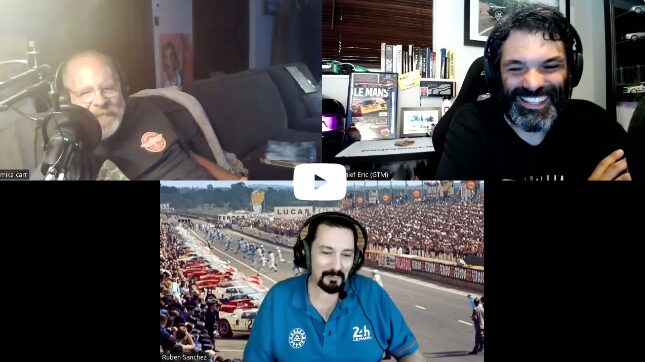
All of our BEHIND THE SCENES (BTS) Break/Fix episodes are raw and unedited, and expressly shared with the permission and consent of our guests.
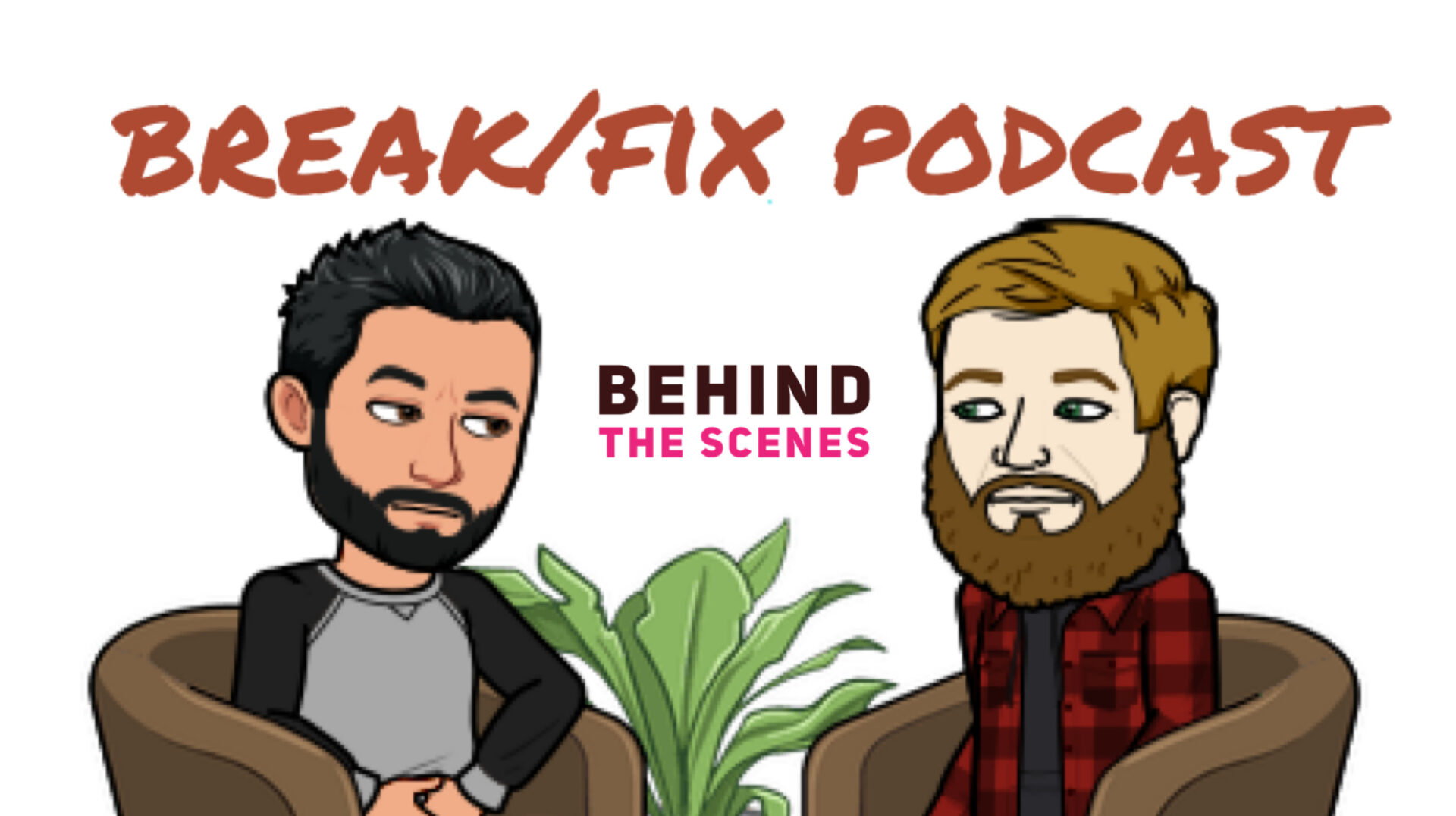
Consider becoming a GTM Patreon Supporter and get behind the scenes content and schwag!
Do you like what you've seen, heard and read? - Don't forget, GTM is fueled by volunteers and remains a no-annual-fee organization, but we still need help to pay to keep the lights on... For as little as $2.50/month you can help us keep the momentum going so we can continue to record, write, edit and broadcast your favorite content. Support GTM today! or make a One Time Donation.

If you enjoyed this episode, please go to Apple Podcasts and leave us a review. That would help us beat the algorithms and help spread the enthusiasm to others by way of Break/Fix and GTM. Subscribe to Break/Fix using your favorite Podcast App:
 |  |  |
Learn More
Join the ACO USA
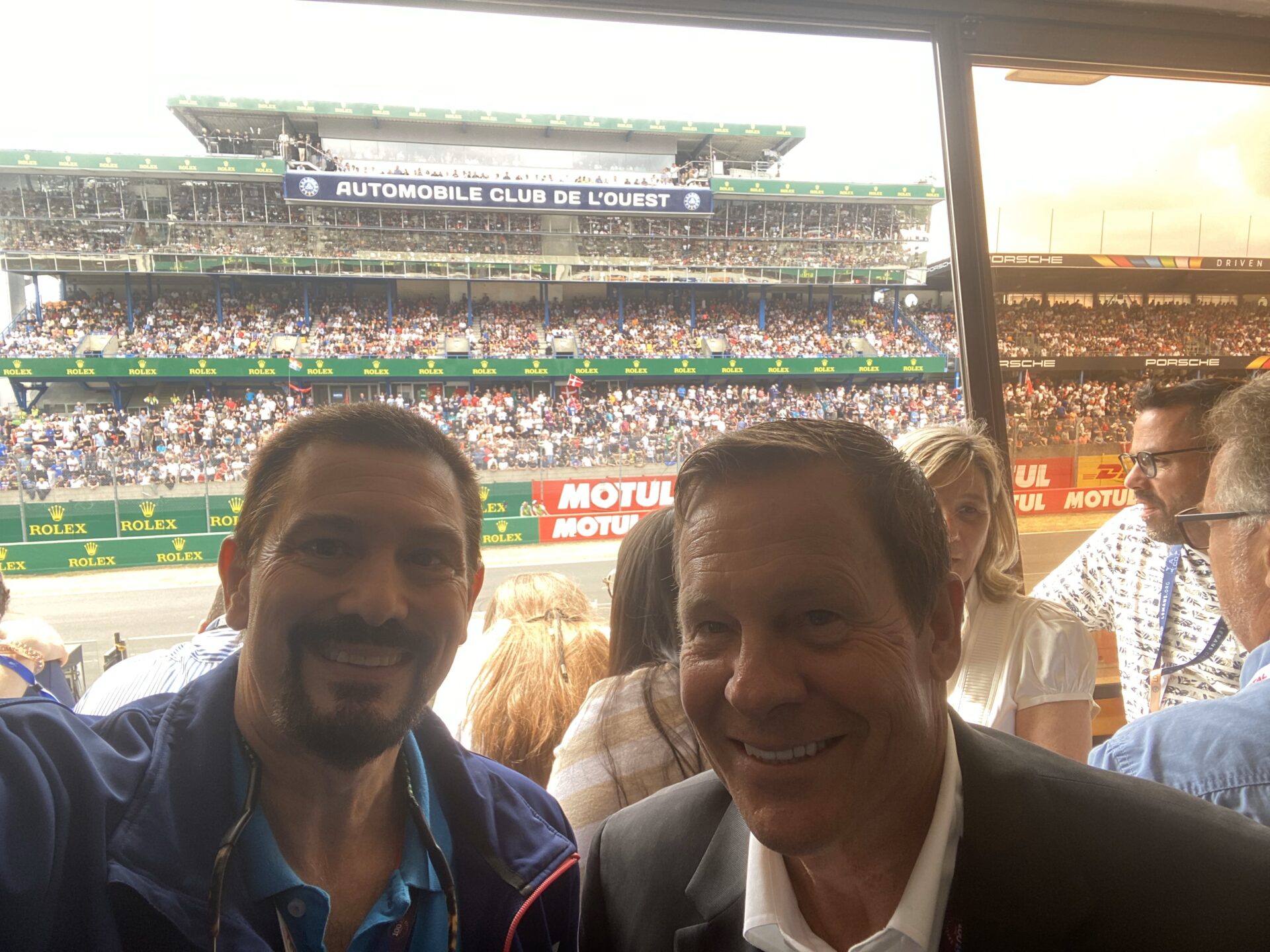
You can learn more about the ACO USA by checking out this episode or David Lowe’s. If you’re ready to become a member of the ACO today, look no further than www.lemans.org, Click on English in the upper right corner and then click on the ACO members tab for Club Offers. As a member you can follow all the action on the Facebook group ACOUSAMembersClub.
To learn more about Ruben or chat about ACO USA, reach out to him via email at r.sanchez@aco-lemans.org
Ruben returned to Le Mans in 1980, again with Diego’s team. Though they crashed in the 15th hour, the experience left an indelible mark.
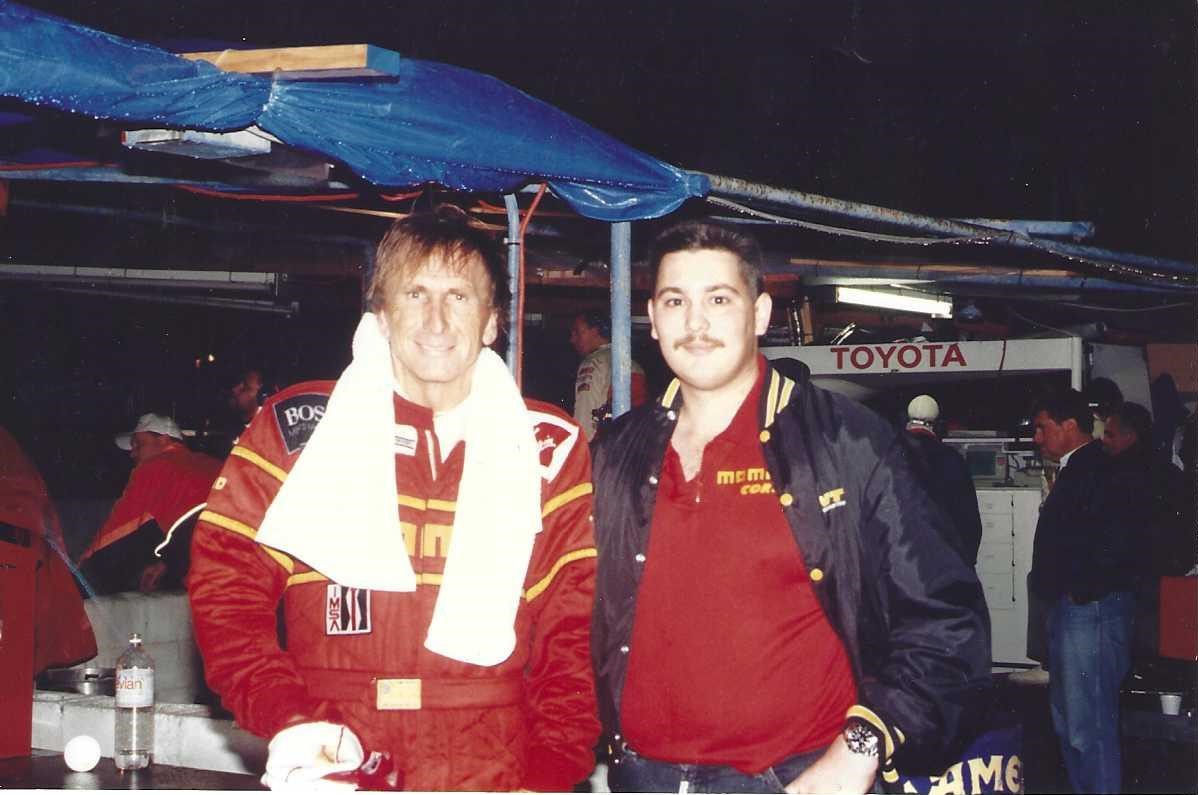
Over the decades, Ruben has attended more than 20 Le Mans races, witnessing legends like Paul Newman, Derek Bell, and Jackie Ickx in action.
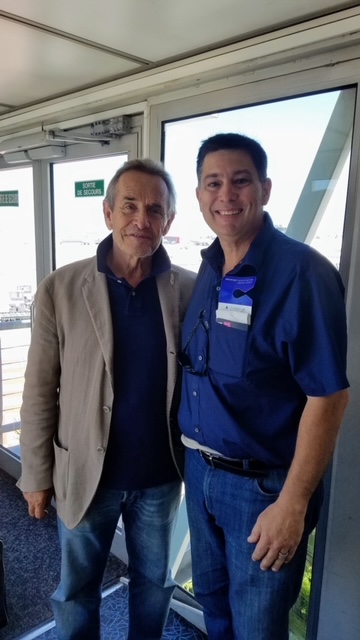
He even had a chance encounter with Ickx years later at an airport (above), leading to a two-hour conversation that spanned decades of racing memories. “He was humble, gracious—everything you’d hope a legend would be,” Ruben says.
From Momo to Offshore Boats
Ruben’s career has been as eclectic as his racing resume. He ran a chain of tire stores, sold Momo wheels like hotcakes, and eventually became Director for Latin America and the Caribbean for Momo. Working closely with Giampiero Moretti, Ruben found himself in the thick of IMSA racing, supporting cars like the Ferrari 333 SP and Porsche 962.
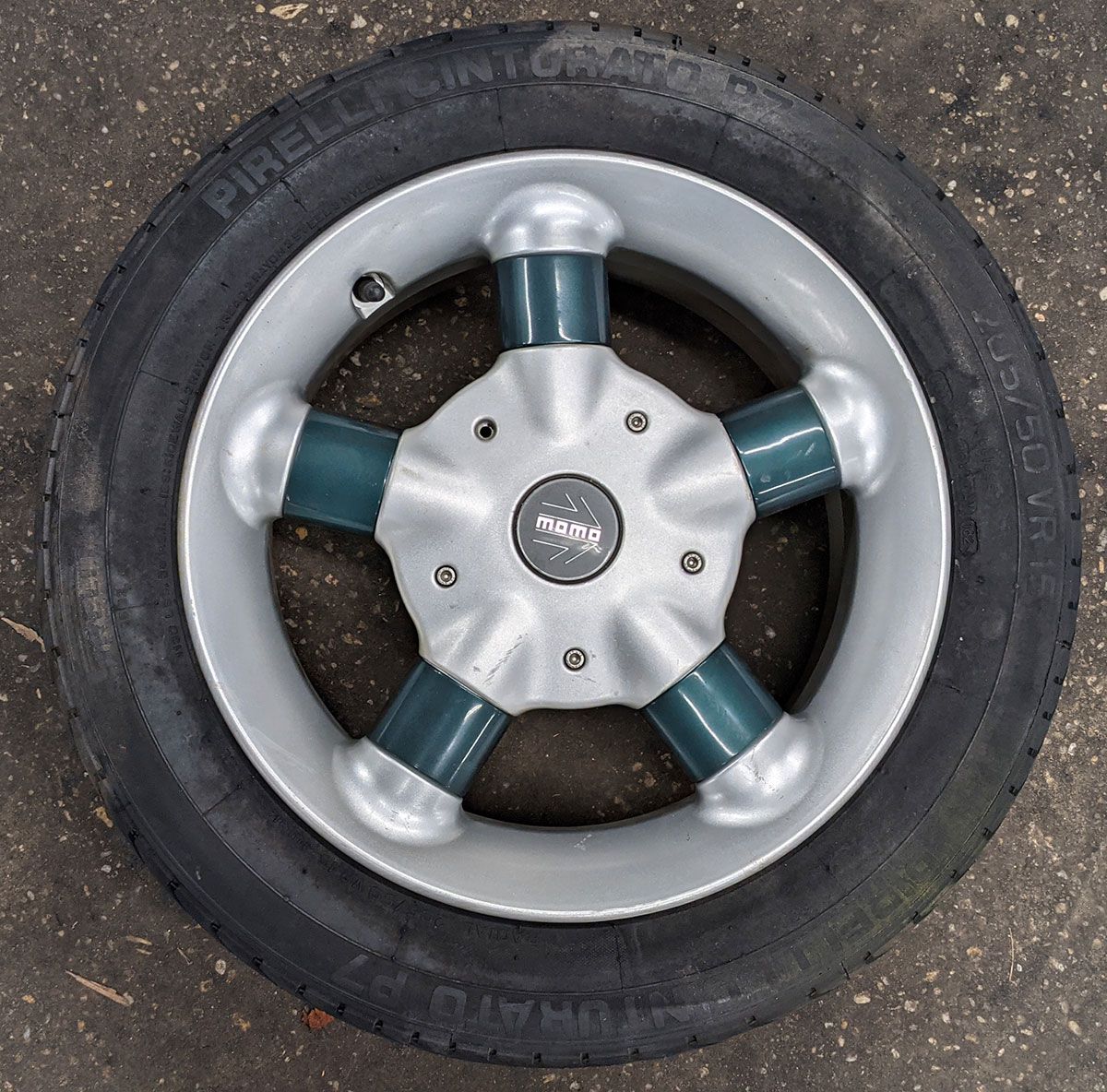
“I sold more Momo Idea wheels than anyone,” he says. “That got me invited to the office, and the rest is history.” He also crewed offshore powerboats, winning the Peace Sportsman class in Key West in 1987 with Jack Roush-powered Fords – one of the few teams not running Chevy big blocks.
Ruben’s personal garage tells its own story. His first car, a Porsche 914, still lives on as his race car. Over the years, it’s evolved into a radical track machine: fiberglass bodywork, swan-neck wing, enclosed cockpit, and a short-stroke 3.2L six-cylinder engine. “It’s almost a Le Mans prototype now,” he jokes. “I’ve had it since I was 16.”
He’s also driven a Martini-liveried Porsche 917, a Ferrari 312PB, and even a Porsche 962—though always with reverence and restraint. “These cars aren’t mine,” he says. “I respect them too much to push them in anger.”
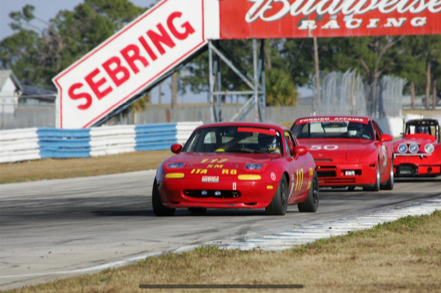
Ruben’s story is more than a motorsports memoir – it’s a living archive of grassroots racing, family legacy, and the evolution of endurance competition. From the smoky garages of 1970s Le Mans to the polished paddocks of modern GT racing, he’s seen it all. “I’ve always loved things that move fast,” he says. “Cars, boats, planes—it doesn’t matter. If it goes, I’m in.”
And through it all, Ruben remains a steward of motorsports history, sharing stories that connect generations and inspire the next wave of petrol heads.
Guest Co-Host: Mike Carr
In case you missed it... be sure to check out the Break/Fix episode with our co-host. |  |  |
And returning with me to co-host this episode is Mike Carr, who some of you might remember from our Randy Lanier and Bob Garretson episodes.


